
This article is a part of our Pride of Omlet series, a collection of amazing stories which shine the spotlight on extraordinary pets and share their selflessness, bravery, talent and compassion with the world.
-Written by Anneliese Paul

Once caged battery hens, Hennifer Marge and Sybil now work free-range with their human Jonathan, transforming lives for offenders at the Rosemead Project. Jonathan (support worker and chicken champion) believes the hens have the power to unscramble tricky social situations.
The Rosemead Project is a residential home in Southend on Sea that exists to get people in need of support on the right path, by learning independent living skills to transform their lives. Six years ago, Southend council granted the project funding to transform the garden. They installed a polytunnel, created raised beds and planted fruit trees.
Jonathan introduced chickens to the garden. The ex-battery hens arrived in a sorry state, malnourished with large patches of missing feathers and pale, floppy combs. But within a few weeks of scratching in the garden and the compost heaps, they were on the road to recovery.
When residents arrive, often from homelessness or prison, they are welcomed into their bedroom, and a bowl containing two eggs sits on the side table with a note that says ‘Welcome from Hennifer, Marge and Sybil’.

Jonathan uses eggs to teach residents how to cook simple meals, like omelettes. He’s put posters up in the communal kitchen with recipes showing different ways of cooking eggs. The eggs have also become currency, cracking once tricky relationships with neighbors. After an anti-social behavior incident, Jonathan visited Jean, one of the elderly neighbors who was nervous about the project. He took eggs and found that they were a good conversation starter.
It was all going well when a fox came. Doris, the mother hen of their original flock, ran towards the fox to protect the rest of them and was left dead. She’s buried in the garden and a lot of the residents were affected by the attack. So on his next egg delivery to Jean, Jonathan told her about the fox and said he would get some more chickens from the British Hen Welfare Trust. Jean came with him and got some hens too. It was a positive moment.
Hennifer, Marge and Sybil arrived, freed from their horrific caged lives. They’ve been with the project for two and a half years now and are the best-feathered support workers Jonathans ever met. Hennifer is confident, Sybil inquisitive, and Marge is really chilled. She can often be found under the lavender bush.
Residents typically stay with the project for two years before going on to independent living, but the path isn’t always smooth, and occasionally, they are sent back to prison. When this happened to one resident, he contacted the Rosemead Project (through his family) to ask if they could send photos of the chickens, they become an important support to many people living at Rosemead.
Another resident says he loves the sound of chickens clucking when he wakes up. It takes him back to a happy place. And another has taken charge and gets up at 7am every morning to let the hens out. Either sitting or working in the garden, the hens build resident’s confidence. “The hens don’t run away from them. That’s important,” says Jonathan.
Some residents like to buy treats for the chickens, which may seem like a small thing, but when it’s a choice between lager or mealworms and they’re choosing mealworms. It’s a good sign. There’s a trail of jobs that come from the hens that’s good for building life skills and the cleaning and care that goes into looking after a pet provides a sense of responsibility.
Jonathan says, “Sometimes, it’s hard to find positives in this job, but it’s a good thing to give something a quality of life, and the chickens are one of the little things that put a big smile on your face.”



This entry was posted in Chickens
Waiting until winter is over to start a flock? The warmer weather typically fans the flame of future flock-raisers, and understandably so — there are several reasons why spring is the perfect time to get chickens. The longer days and awakening earth make for ideal conditions for hens and chicks alike. Find out how to get started with chickens this spring, and what to expect through the rest of the year.

When should I buy my chickens?
The term “spring chicken” originated in the 1700s, when farmers realized that chickens hatched in the spring were being bought at a better price than those who had already been through their first winter. Most breeders now begin hatching eggs in December, which has pullets reaching laying age by spring.
Most laying breeds of chickens begin laying eggs between 16-22 weeks of age. If you purchase chickens that were hatched in December, you can expect to start seeing eggs around April. You’ll likely see just a few eggs to start with, but their production will increase as your pullets mature through their first year.
If you start out with chicks in the spring, they should begin laying eggs toward the end of summer. But you also run the risk of chicks being hatched too late in the spring to begin laying before their annual fall molt, which will push egg production into the winter or even the following spring.
How long will spring chickens produce eggs?
Chickens will continue to lay eggs throughout their lives, with their peak production age being around 30 weeks of age. After they’ve turned their first year, hens will begin to slowly produce less eggs over time, decreasing around 10% each year. Most hens will have stopped laying eggs by the time they’re 6 years old, but some breeds or individual hens may continue to lay infrequent eggs for the duration of their lives.
Feeding your chickens a quality diet of layer pellets or crumbles containing at least 16-18% protein will help them in their egg production efforts. Fresh fruits and vegetables, dried insects, and foraging will also help your hens meet their nutritional needs. Make sure your flock always has access to fresh water, and keep crushed oyster shells or another calcium supplement out free-choice in their chicken run to help fortify eggshells.
You can expect your hens to lay fewer eggs, or none at all, during their annual chicken molt. This occurs during late fall, when the daylight hours begin to shorten, triggering the process of chickens shedding their feathers to grow fresh plumage for the winter. Once your hens have donned their winter coats, egg production will resume as usual. The molting process can take anywhere from 4-12 weeks, but on average you can expect to see fewer eggs for about 6 weeks.
Why is spring the best time for chickens?
Spring has everything that chickens love: mild weather, fresh vegetation, plenty of insects, and longer days to spend foraging. And as a chicken keeper, you get to enjoy these natural buoys to make your workload a little lighter and your days more joyful. There’s nothing like watching your flock scratch the ground while you relax on a calm spring afternoon.
Spring consideration: parasites
The earth isn’t the only thing waking up during the spring — parasites will also be making their comeback. For chickens, the main parasites to be wary of are red mites. Their presence drops off during the colder months, but as the weather warms back up, they’ll be ready for their yearly debut.
Watch your flock closely for signs of a red mite infestation. These include:
- Reluctance to roost, as mites lie in wait for chickens overnight
- Lethargy
- Sensitive skin or feathers, or persistent scratching
- Pale combs or wattles, as this can be a sign of anemia
- Irritation on the skin of the legs
Red mites hide in the crevices of wood, and are very hard to eradicate once they’ve infiltrated a coop. Treating your flock and their coop is tedious, and many treatments have to be administered repeatedly. Preventing red mites is the best line of defense against these opportunistic pests. Eglu plastic chicken coops prevent red mites from hiding, and can be pressure washed easily to eliminate any parasites that may be present.
Chicks in the spring
Spring is a very popular season for chicks. Most farm supply and feed stores stock chicks during the spring, and hatcheries are hard at work hatching higher volumes. This is largely due to the mild weather that spring brings, which makes transitioning chicks from a brooder to their outdoor run easier when the time comes. If you’re looking to raise chicks, starting them in the spring will allow you to move them to their permanent setup during the summer, which will ensure they’re warm enough. Some chicken keepers wait to raise chicks in the fall so that they’re ready to lay the following spring.
Whichever season you choose, you can expect to keep your chicks in a special setup called a brooder for the first 6-12 weeks of their lives. Chicks need a heat source until they are fully feathered, a milestone they usually reach by 6 weeks of age. Chicks younger than 12 weeks should not be expected to navigate a coop on their own, and should stay in their brooder until they are coordinated enough to head to their roost at night. Once they’ve reached 12 weeks of age, you can transition your chicks to their coop.
Prepare for the rest of the year
If you’ve decided to get chickens this spring, it’s a good idea to make a plan for the rest of your chicken-keeping year. Invest in chicken run covers to keep spring showers and summer storms from turning their run into a mud pit, and later to prevent snow and ice from freezing their feet. Outfit their area with some chicken toys and perches for year-round entertainment and enrichment, and install an automatic chicken coop door to simplify your schedule. These accessories are the perfect addition to further simplify spring chicken keeping, and will lend support in every season.
Omlet and your flock
Getting new chickens is exciting — no matter what time of the year it is. Outfit your flock with chicken keeping products that support their behaviors and your lifestyle. When you choose an Eglu Chicken Coop, Walk In Chicken Run and Chicken Run Covers, you’ll equip your flock with everything they need to stay safe and comfortable all year long.
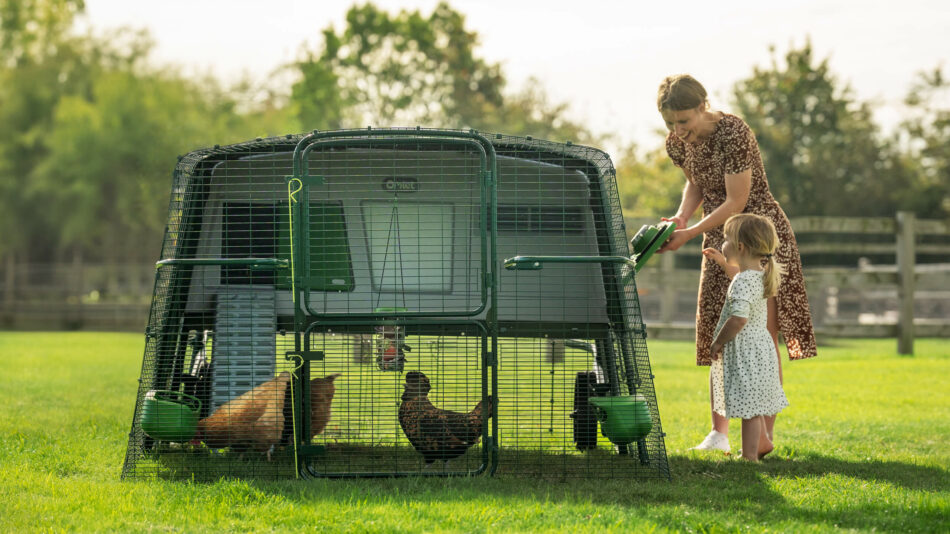

This entry was posted in Chickens

Photo Photo by Erik Karits from Pexels

Chickens and green eco-living go hand in hand. Hens are a great part of the ecosystem of a healthy garden, and they also ‘recycle’ a lot of food that would otherwise be thrown away.
Converting scraps into eggs is a powerful symbol of eco-friendly living. Keeping your own hens is also a significant step in the direction of a ‘green’ lifestyle. No intensive rearing, crowded barns or other ethical issues involved!
Kitchen scraps can be a healthy supplement to your hens’ pellet-based diet. Chickens are omnivorous and will eat most of the things you offer them, including cooked pasta, wholemeal bread (soaked in water to avoid it swelling in the bird’s crop), green vegetables, cereals, cooked meat (nothing cured or salted), banana, sunflower seeds, alfalfa, pumpkin, courgette, butternut squash, sweet potatoes and cucumbers. If you hang a cabbage or broccoli stalks in the chicken run, the hens will have great fun pecking at it.
Treats such as bread, cereals and pasta should only be fed in moderation, as they have little nutritional value and can cause your chickens to pile on the pounds. Dairy products and too much lettuce (especially Iceberg varieties) can cause diarrhea, so these should also be avoided.
Chickens enjoy many garden plants, including nettles and dandelions. There are several toxic wild foods, though, and this is a hazard when feeding wild-sourced foods. A good starting place is the Plants and Foods that are Poisonous for Chickens page in Omlet’s online chicken guide.
Foods that should never be given to chickens
 Potatoes, tomatoes, and aubergines (eggplant) are in the Nightshade family, and they are toxic for chickens. That applies to all raw forms of these foods. The toxic ingredient, solanine, is broken down when the plants are cooked, and so cooked potatoes or tomatoes will not cause problems.
Potatoes, tomatoes, and aubergines (eggplant) are in the Nightshade family, and they are toxic for chickens. That applies to all raw forms of these foods. The toxic ingredient, solanine, is broken down when the plants are cooked, and so cooked potatoes or tomatoes will not cause problems.
The other everyday foods that you should never feed to chickens are apple seeds, avocados, chocolate and other confectionary, salty foods such as bacon, cheese and crisps, dried raw beans and pulses, and raw garlic, onions and leeks.
Citrus fruits are mildly toxic, and although they will not kill your chickens, if fed in excess they will cause diarrhea and a drop in egg production.

Photo by Tetiana Bykovets on Unsplash
It also needs emphasizing that all kitchen scraps offered to chickens should be fresh. Any moldy food should be thrown away and not fed to chickens, other pets, or wild birds.
Overripe and wilted vegetables or stale bread are all fine as long as there is no mold present. Photo by Ayda Oz on Unsplash
You should only feed wild plants to chickens if you know they are safe. First, you need to identify the plant. If you are in any doubt, don’t give the plant to your chickens.
…And don’t forget the chicken manure
The food waste fed to chickens isn’t all transformed into eggs, of course. Some of it is ejected as chicken poo, and this is an excellent fertilizer once it has been rotted down. Chickens droppings should never be applied fresh to vegetable or flower beds, but should be added to the compost heap along with the soiled bedding from the coop.
In intensive hen farms, waste is a big problem, as run-off from accumulated chicken droppings can pollute rivers. On the small scale of backyard hens, though, composted chicken poo is a great benefit to the garden.
How chickens help you stop wasting food

When you feed kitchen scraps to chickens, you suddenly become aware of what you and your family are wasting. Those scraps are all things that were being routinely thrown away before you invested in a chicken coop and a few hens.
This may make you reassess your buying and cooking habits, and it puts the notion of food waste into a new perspective. As a result, you may stop cooking more than you need, and you may stop bulk-buying and keeping veg in the fridge until it rots. If finances are tight, these details can make a big difference to the family budget.
To begin with, you may have enjoyed taking all those leftovers out to the hens, but once you start to question the cost of it all, it gets you thinking. How much are you effectively ‘spending’ on kitchen waste for your chickens? After all, the hens can get all the nourishment they need from a diet of layers pellets, grain, grit and lots of dandelion leaves. They don’t actually need those kitchen scraps.
Once you’ve found a balance here that suits your lifestyle, it can lead to other positive changes in your attitude to waste and sustainability in general. Your chickens can teach you, in a roundabout way, to reduce food waste, and that poses the question – what other waste could you reduce? The list here is endless, but it begins with single-use plastics and other environmentally unfriendly products and packaging. We’ve moved a long way from the throwaway culture of previous decades, but there’s still a long way to go.
Photo by Anna Shvets from Pexels
How local communities use chickens for anti-waste campaigns
Some communities have taken this thinking to its logical conclusion, reducing personal waste on the one hand and, on the other, making sure nothing is wasted. Chickens are the beneficiaries here. Any appropriate waste food – from households, restaurants or shops – is collected and fed to the communal flock. The hens convert the waste into eggs, which are enjoyed by everyone involved in the community scheme. There is very little extra expenditure involved, so people are, in effect, getting their eggs for free.
To give a large-scale example of this, in Austin, Texas, a local authority pioneered a zero-waste food program a few years ago, paying people in the area to keep backyard chickens. The hens were fed solely on waste food, of sufficient variety and high quality to satisfy the birds’ nutritional requirements. The goal was to reduce the amount of food entering landfills. In redirecting it to backyard chickens instead, there has been a substantial reduction in landfill-derived methane emissions.
Some schools in the UK, the USA and elsewhere have taken up this anti-waste challenge too, channelling the community’s waste food to their chickens. It’s certainly food for thought!
The thought of household waste being converted into fresh eggs is a very pleasing one. Taking that concept to the community level is an exciting idea, and it’s possible that such schemes are about to become commonplace.

This entry was posted in Chickens

This article is a part of our Pride of Omlet series, a collection of amazing stories which shine the spotlight on extraordinary pets and share their selflessness, bravery, talent and compassion with the world.
-Written by Anneliese Paul



Martha’s humans, Nicola and Ben, bought chickens to bring joy to Julia, their mother who they cared for at home. The family could never have imagined that a chicken would become a caring companion to Julia in the advanced stages of dementia.
Julia used to have chickens as a child. She fondly told Nicola stories about dressing up the chickens and wheeling them around the garden, like babies in her toy stroller. However, it wasn’t until her 90th birthday that Julia actually owned chickens again. It was a dream come true.

Nicola and Ben always thought they didn’t have enough space in their bungalow garden, but while visiting relatives in Ireland, Ben saw an Omlet ad and brought it home to show Nicola. “That’s just what we need,” she said. The Eglu arrived soon after, and then their two hybrid chickens moved in. Julia named them Martha and Mary.
While Mary was always shy and kept her distance. From day one Martha ran to Julia, Nicola’s mum. “She was mom’s best friend from the beginning,” says Nicola.
Unfortunately, Mary died and then there was a near miss for Martha. Like most people, the family liked to let their hens roam free in the backyard for a bit, but one day a fox came into the garden and attacked Martha. Nicola and Ben heard her squawking and went to the window. The fox saw them and ran, leaving poor Martha very shaken and suffering from a broken wing. Martha was brave though, and luckily the wing has completely healed. Now Ben and Nicola have extended the run so the chickens only come out when they are present in the garden.
When it was sunny, Julia liked to sit outside in the sun watching Martha. Julia had to use a wheelchair, and Martha would jump (in a very ladylike way) onto the footrest to warm her feet. Last Summer when Julia could no longer speak in sentences, she’d make gentle noises and Martha would answer back. She’d sit for hours by the wheelchair with Julia, having quiet conversations.
Nicola couldn’t deny Martha had a human quality. She didn’t just come for crumbs because she was there when there weren’t any. Martha cared.
“She went from a chicken, running around the garden then in those moments with mom, it was like she knew. It was beautiful.”
Nicola began to trust Martha to squawk loudly if something was wrong. When she went into the house to make a cup of tea, she’d leave Julia in the garden with Martha.
“It was weird,” says Nicola “ Martha would squawk, and I’d go out to find Mom had dropped something, or something had fallen off the table, or Mom was confused because she didn’t remember where I was.”

Martha was the thing that made Julia smile every time, and her eggs brought so much joy to Julia in the advanced stages of dementia. Boiled was her favorite, and Martha would let them all know when it was ready to be collected. When Martha lays an egg, she stands at the edge of the run and squawks and squawks as if to say, “Come and get my egg!”
Julia loved holding Martha’s warm eggs. Once, when Julia was having a nap, Nicola took her the freshly laid egg. She’d just woken up, and a big smile spread across her face, then she fell asleep again holding it. A couple of hours later, Nicola went to wake her up. Julia sat up. All of a sudden, the egg rolled out from behind her as if she’d laid it on the bed. Incredibly it was completely intact. “Are you laying eggs now?” asked Nicola. Julia understood, and that made them all laugh. It was the happiest occasion, just an egg rolling along the sheet. Julia kept the egg in her hand for the rest of the day. Moments like that are precious memories to Nicola and Ben.
Sadly, Julia died in September. When Julia was alive, it was Mom and Martha, Nicola says. She never thought she’d make a connection with chickens. However, having seen how Martha cared, chickens have become constant companions.
“ I think we’ll probably always have chickens because they get under your skin. Well, no, that’s a bad expression. They become part of you. They’re like a little family.”




This entry was posted in Chickens
Having an automatic chicken coop door is an amazing technological advantage when keeping a flock. There are many ways that having an automatic coop door makes keeping chickens easier than ever, but there are 5 reasons you need the Smart Autodoor this summer that stand out among the rest. Discover newfound ease of chicken keeping and peace of mind this season when you upgrade your coop with a Smart Autodoor by Omlet.

What is a Smart Autodoor?
A Smart Autodoor is a revolutionary way of keeping chickens. Omlets automatic chicken coop door is a customizable, horizontally opening door for chicken coops, runs, or handmade hen houses. You can program the Smart Autodoor to open and close on a schedule of your choosing, or manually from your smartphone, tablet, or even Alexa or Google Home device. With these smart features in mind, here’s why having a Smart Autodoor will bring you and your flock big benefits this summer.
No more early mornings
When school is out, late mornings are in. Unfortunately, your flock doesn’t understand the concept of summer break. That’s where the Smart Autodoor comes in – simply program your door to open at a specified time in the morning, with the dawn, or from a push of the button on your phone. And, with Alexa and Google Home device integration, you can ask your virtual assistant to let your chickens out so that you and your family can sleep in.
Automatically adapt to the longer days
Summer brings longer days, which will affect the amount of time your flock spends outdoors. When you use the daylight sensing option of the Smart Autodoor, your coop door will automatically adjust for the growing daylight hours. Closing at dusk with the soft beckoning of a coop light, your flock will be able to enjoy pecking around their chicken run or yard during the cooler evenings all the way up until it’s time to roost. You can take your time grilling, swimming, or relaxing in the AC, knowing that your chickens are being safely tucked in automatically each evening.
Access coop information from anywhere
Wondering if your automatic chicken coop door is opened or closed? Need to turn on the coop light so to do a roost check with your coop camera? All of this and more can be accessed through Omlet’s Smart Autodoor app, available in the App Store and Google Play Store. All the app needs is a data connection to touch base with your smart panel – which means you can check in on your flock from anywhere in the world. Now that’s smart chicken keeping.
Improved coop security
The warmer weather has chicken predators retreating to their hideaways during the heat of the day. But as night falls, so do the temperatures – and predators will be out on the prowl, hungry and eager for an easy meal. To prevent predators from treating your chickens’ coop like a diner, the Smart Autodoor opens and closes reliably in all weather conditions, safely sealing your hens inside. The horizontal open and closing mechanism is incredibly difficult for predator paws to pry open, making your hen house a flock fortress.
Easily convert your current Autodoor with a Smart Panel
Already have an older model of the Autodoor? No problem – an Autodoor Smart Panel can be added to Omlet’s Autodoor. Simply disconnect the old control panel, put batteries or wire in the new panel, and reconnect the cables for an instant smart-upgrade. Once your new control panel is installed, simply download the app, and have full control of your chicken coop door and coop light right at your fingertips.
A summary of coop-safety tips
As summer hits its full-swing, it’s important to keep seasonal safety tips in mind. By preparing your flock for the warm season, you and your hens will be able to rest easy in your respective houses. To keep your chickens safe this summer, remember to:
Omlet and your summer flock
Enjoy summer with your flock with our line of ingenious chicken products. From chicken fencing to add foraging options, to fully enclosed chicken runs with optional covers to provide plenty of shade, you and your hens can make the most of summer together. Add the Smart Autodoor to your setup for reliable flock security when your nights or mornings run late, or for spontaneous summer weekend trips. With Omlet, you’ll look forward to summer chicken-keeping, and be able to relax knowing your flock is in the best setup possible.
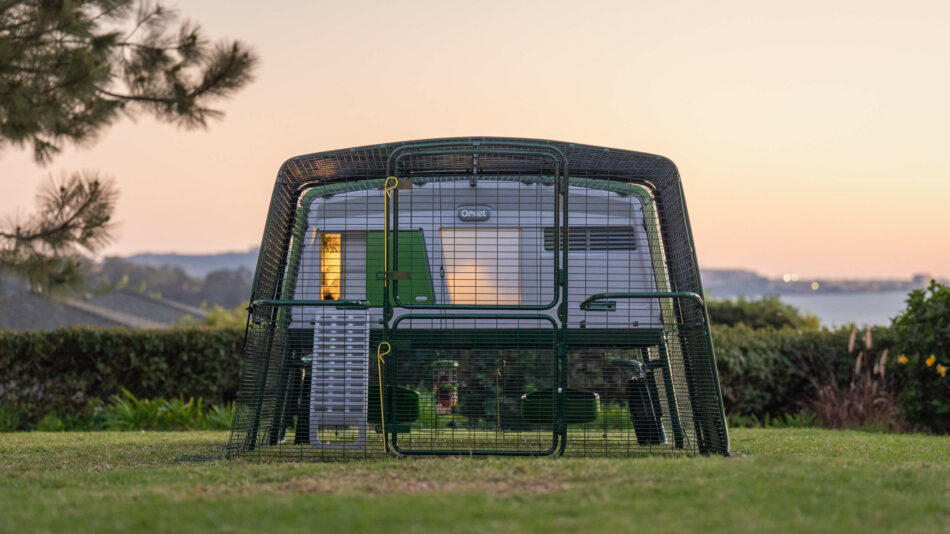

This entry was posted in Chickens
 Having some feathered friends in your backyard who regularly lay eggs for your enjoyment – that sounds good, doesn’t it? But there are a few things to consider before raising and keeping chickens in your backyard. Whether your garden is suitable for chicken keeping or the actual costs which are involved… In this respect, we’re going to be “egg-ucating” you today with some advice and guidance!
Having some feathered friends in your backyard who regularly lay eggs for your enjoyment – that sounds good, doesn’t it? But there are a few things to consider before raising and keeping chickens in your backyard. Whether your garden is suitable for chicken keeping or the actual costs which are involved… In this respect, we’re going to be “egg-ucating” you today with some advice and guidance!
What does it cost to keep chickens?
The regular running costs include feed, bedding, sand, lime, water and electricity. Depending on the breed and age of your chick and the type and quality of the feed, you should expect about $15 for five chickens/month. If your chickens also find a lot of feed in the run, you can keep the costs quite low, while high-quality organic feed costs significantly more. You can also budget stuff such as cabbage, cauliflower leaves or spinach to supplement their pellets, as hens do need a bit of greenery in their daily diet. Bedding cost approximately $20.
 In addition, there are costs for the vet, which can hardly be calculated. The vaccination costs are still quite manageable, the vaccine itself is a maximum of $30 . Depending on what you want to vaccinate your chickens against and whether you also deworm regularly, the costs naturally increase. With other health supplements we can calculate $70/year.
In addition, there are costs for the vet, which can hardly be calculated. The vaccination costs are still quite manageable, the vaccine itself is a maximum of $30 . Depending on what you want to vaccinate your chickens against and whether you also deworm regularly, the costs naturally increase. With other health supplements we can calculate $70/year.
To answer simply, the maximum cost to raise chickens in your backyard will be $50/month, for a flock of 5 hens. Basically it can be said, chicks are cheaper than other pets like dogs or cats and we even receive some delicious eggs from them.
Please be aware that all prices listed here are very general estimates and can vary greatly from state to state and between cities and towns.
Besides these running costs you should definitely purchase a convenient and practical chicken coop to keep your pullets safe. You can buy a pre-made coop or you can build your own. Something that definitely needs to be on the list is a food and water dispenser, a perch and at best some peck toys and a treat holder for the cleanest and healthiest way to feed treats to your flock.
to keep your pullets safe. You can buy a pre-made coop or you can build your own. Something that definitely needs to be on the list is a food and water dispenser, a perch and at best some peck toys and a treat holder for the cleanest and healthiest way to feed treats to your flock.
And don’t forget the costs of chickens themselves. These costs depend on the breed and their age. A good starter flock usually consists of 4 to 5 birds aged 16 to 24 weeks. If you’re up for a special breed or pedigree chickens, the prices might be more expensive. The chicken costs may vary between $7 and $15 per chick.
What is the workload and do I have enough time to keep chickens?
The daily workload depends on the size and age of your flock, and how well you pre-planned. It is to be expected that newly hatched or baby chicks might need much more of your time than adults. For finding out which chicken age is more suitable for you, please refer to our previous blog: ‘Chicken keeping for beginners: adult chickens or baby chicks?’.
Generally you can say, the more chickens you have, the more work there is to do – but also the more eggs that will make you and your family happy each morning! However, keeping chickens in a small flock with around 6 animals is much easier than keeping a dog. You will need to feed your flock and change their water daily, and give them all a quick daily health check. You should let your chickens out of their coop at least once a day, either on a free-range basis or in an enclosure, which will keep them safe from predators.
Another important factor you should keep in mind is your working hours. If your work starts in the early morning or in the late evening, it’s difficult to prioritize letting your chickens out of the coop and back inside again. However, this doesn’t necessarily imply that you are not able to keep chickens at all. For this, it’s a good alternative to purchase an Automatic Chicken Coop Door, which can completely open and close automatically, even when you’re not there!.
With an effort of approximately 10-15 minutes workload per day, you will be able to take the essential actions to keep happy and healthy chickens (plus any extra play and cuddle time you choose!).
Is my environment suitable for keeping chickens?
 In order to keep healthy and happy chickens it is necessary to have a safe outdoor area with plenty of space, where they can exercise and enjoy the sunshine and fresh air. Your chicks should be able to go about their normal behaviors, such as scratching, foraging and dust bathing.
In order to keep healthy and happy chickens it is necessary to have a safe outdoor area with plenty of space, where they can exercise and enjoy the sunshine and fresh air. Your chicks should be able to go about their normal behaviors, such as scratching, foraging and dust bathing.
The selection of the chicken breed as well as how many chickens you want to keep are the key indicators for the necessary space requirement. You should definitely give your chickens plenty of green space to enjoy their freedom. However, it is important to have a coop and an outdoor enclosure to keep your chickens safe from predators when you’re not around.
If you are looking for a resource for all things chicken keeping please check out Backyard Pets. They have reviewed our Eglu Cube and offer great resources through their site here.
Who takes care of my flock if I’m away?
Whether you’re planning a short time away from your flock or a longer trip – with appropriate planning there are ways to manage it, so you can leave your chickens without a guilty conscience.
The most convenient and easy way would be to ask a friend, family member or your neighbor to keep an eye on your flock while you’re away. If you can’t find someone around you, don’t worry. Ever heard of a chicken sitter? Yes, they do exist. Investigate in your local area whether a chicken sitting or boarding service is available. As for dogs or cats the same goes with chickens: the ideal chicken sitter is one who knows poultry well.
An alternative is to invest in an automatic feeder. It allows your flock to get access to food all day at will and keeps rats or other unwelcome guests away. Another great item would be an Automatic Chicken Coop Door, where you can set the time via the control panel, when the door will open and close the coop at a certain time or based on the rising and setting sun, so they can still enjoy their freedom when you’re not home.
Can I mix different breeds of chicken?
Yes, in most cases you can mix breeds of hens, while it is better to let roosters be on their own.

If it comes to age, older chickens can sometimes bully chicks simply because of a pecking order issue. Suddenly, there are new chickens in the coop, and the older chickens want to establish themselves at the top of that pecking order but this is a natural conscious behavior and has nothing to do with the breed itself.
Real problems may occur by “mixing” breeds when you have e.g. five chickens that are very similar looking (like Rhode Island Reds and New Hampshire Reds) but only one chicken with a very different look. Chickens who look entirely different from the rest of their flock can get picked on.
Some crested chicken breeds e.g. the Polish do not see very well, because their crest feathers are in the way, which can be a disadvantage and might lead to getting pecked.
The most important thing to remember when integrating new birds into an existing flock is to isolate or quarantine all new birds for at least 30 days. This gives you time to observe all new birds for symptoms of disease and/or signs of external parasites and to treat them if necessary. Then once the 30 day isolation period is completed, introduce new chickens or chicks to the flock and always monitor the interactions between old and new chooks up close and personal until you’re sure that all is well. When they feel comfortable and get along, a simple daily check-up will do fine. For acquaintance, allow your chickens to free range and mingle together. More information regarding introducing new chicks to your flock you can find here: https://blog.omlet.co.uk/2020/04/26/how-to-introduce-new-chickens-to-your-flock/
Always remember, your feathered friends are living animals and you’re making a commitment to care for them properly. Make sure you have sufficient time and space for them to live happily and healthily.
If you keep your chickens in the above stated conditions, they will be grateful and thank you with some snuggles and delicious eggs. The better the pre-planning, the more relaxed you will be and the more satisfied your chickens will be.
This entry was posted in Chickens
You can buy chickens when they are still chicks, or you can choose ‘point of lay’ hens (also known as started pullets). These are ready-to-go birds that are about to begin laying eggs, and they offer the easiest entry into the wonderful world of chicken keeping.
If you choose to buy chicks or hatch fertilized eggs laid by your own hens, you will have to care for the young birds for the five months before they start laying. They are extremely cute but delicate little things, and easy prey for cats, rats and other creatures that wouldn’t attempt to attack a full sized hen. You will also need to keep them warm, which means investing in special equipment.

So, if you are simply keeping chickens for fresh eggs, you should start with adult birds rather than chicks.
Why buying point-of-lay hens?
This is the entry point for most people who are new to keeping chickens. By checking availability in your local area, you will be able to source birds close to home. The advantages of choosing these older birds pretty much outweigh all other options, and the only reason you would opt for buying or hatching chicks is if you want to look after small birds. For many people, this is a very rewarding activity, but for someone who just wants to look after laying hens, started pullets are the way forward.
Why keeping ex-barn hens?
Another great way to stock your coop is with rescued chickens. Intensively reared hens kept in barns are judged to be past their prime after a year and a half, even though they still have a good 18 months of laying ahead of them. For the majority, this is the end of the road. However, charities such as the Animal Place in California relocate these hens and give them new homes.
All ex-barn hens have great charm and personality. They tend to look rather bedraggled and sad when first rescued from their imprisonment, but with a bit of TLC they will blossom as impressively as the Ugly Duckling!
What do I need to know about buying chicks?
You need to be sure that you buy baby hens and not cockerels. There are no external clues as to what sex a chick is, and any stock sold sight unseen (or ‘straight run’) will be a 50/50 mix of male and female birds. You need the chickens to be sexed to ensure you get hens. If this is not possible, wait for started pullets to become available.
Chicks need special accommodation for the first few weeks, and they can’t simply be kept in a standard coop and run. You can buy brooder boxes to keep them, or you can improvise one using a cardboard box or plastic bin with holes in the side. The important thing is to keep the birds warm and protect them from drafts while ensuring good ventilation.
After transferring your chicks to their brooder, pay close attention to how they behave. If they’re crowded together directly under or adjacent to the heat source, they’re cold. Lower the heat source closer to them or add another. If, on the other hand, they shy away from it, they’re too hot. In this case, the heater or bulb will need to be moved further away.
What do I need to know about chicken brooders?
You will need to provide 6 square inches (39 square cm) per chick in the brooder. Once they are five weeks old they can be moved to a coop and run, where they will need at least two square feet (0.19 square meters) per bird. You can buy brooder boxes to keep chicks in, or can make one yourself using a cardboard box or plastic bin with holes in the side. The important thing is to keep the birds warm and protect them from drafts, while ensuring good ventilation.
The chicks need to be kept in a temperature of 35C (95F) in their first week. The heat should be reduced slightly each week until you’ve reached room temperature. A heater designed for coops and aviaries is the best option. A red heat bulb is another option (not a white one – these produce glare that keeps chicks awake at night and tends to make them irritable and prone to pecking). Standard light bulbs will not do the job.
Very young chicks will need to have their water changed at least twice a day, as they have the ability of turning all liquids to messy soups within a few hours! They also need their bedding changed at least once a week. A chicken wire covering for the top of the brooder is recommended, too. Chicks can easily ‘fly the nest’ if the sides of the brooder are less than 1’5″ high.
Chicks can spend a little time outdoors when they’ve reached two weeks. A large wire cage or some other type of portable enclosure can be placed outside for a few hours a day – but only if it’s at least 18C (65F) and not too windy, and dry. The birds will need food, water and shade, and shouldn’t be left alone for very long. Predators are everywhere when you’re a small chick!
Once they’ve reached four to five weeks, the chicks can be moved permanently into the outdoor chicken run.
Do I want to breed my own chickens?
Another way of keeping chickens is to keep the flock refreshed by hatching eggs from their own chickens. The easiest way of raising chickens is to let nature take its course. All you have to do is provide a nest box for a broody hen. She will provide the right conditions for hatching eggs (although she will not be able to cope with more than a dozen at a time, or fewer with smaller breeds), warming and turning them as necessary. An incubator is the alternative hatching method.
A cockerel will do everything in his power to tread the hens in his flock and fertilize the eggs. If a chicken is broody, she will then sit on the eggs for 21 days (the incubation period), and with a bit of luck these eggs will then hatch.

Rearing chicks is a great hobby, but you need to be dedicated to the job. If all you want is fresh eggs and a flock of healthy and happy adult chickens wait for point-of-lay birds to become available. Also, contacting a local hatchery for more information is always a good move.
This entry was posted in Chickens
Whether you’re a beginner or experienced chicken keeper, we have put together a list of 10 essential products you should consider having to hand if you decide to keep chickens in your backyard.
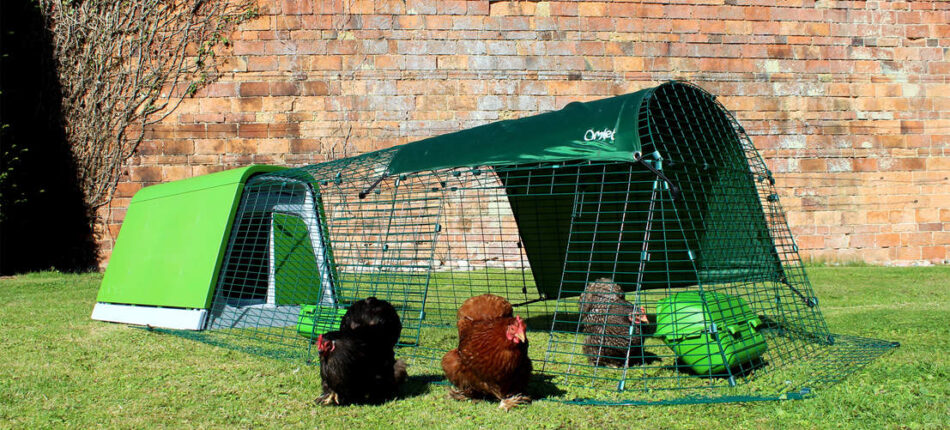
Image by Xuân Tuấn Anh Đặng from Pixabay
Certain accessories and equipment are essential to keep your chickens safe and healthy.
The products to have on your shelves
- Diatomaceous earth: a must! Diatomaceous earth is a natural and completely organic product which can be sprinkled in the chicken house to prevent the proliferation of red mites. You can also treat your chickens by mixing it with their feed, or dusting them with the powder and incorporating it into their dust bath.
- A coop disinfectant. The shelter, equipment and accessories of your chickens must be cleaned regularly to keep their home hygienic and healthy. Use a pet safe disinfectant, like Battles.
- Cider vinegar has many benefits. A little cider vinegar in your chickens’ water will help to improve their respiratory system, boost their immune system and maintain a healthy digestive system. Warning: do not use cider vinegar in metal drinkers. This breaks down the metal and can create a toxic chemical reaction for your chickens. Want to clean your eggs but water is not enough? Use the cider vinegar by dipping your eggs in it for 10 seconds. They will be impeccable! You can even add cider vinegar to the water before washing your chickens. Finally, clean your drinkers and equipment with apple cider vinegar to remove traces of limestone. Vinegar is a whitener and a very good disinfectant.
- Grit: Having grit on your shelf is essential. Your chickens don’t have teeth, so grit helps your chickens digest the grains and other foods they eat more easily. The ingestion of grit is a physiological need essential for the good health of your flock.
- Food supplements: Chickens eat a lot and tend to peck at the ground in search of small insects, but did you know you can buy dried insects, rich in vitamins and nutrients, to support your chickens’ diet? A chicken eats an average of 120 g of food per day. Food supplements can be great for maintaining your chickens’ health and egg production and providing them with their daily dose of vitamins. For example, chickens need calcium and phosphorus to produce quality eggs. This is ideal for ex battery chickens. Garlic powder is recognized for its many virtues. Added to the daily feed of your chickens, it will improve their immune system, deworm and eliminate red lice and mites.Did you know that herbs are great for their immune system and that it protects your chickens from infections and intestinal parasites? A herb treat mix will support their health and happiness!
- Vaseline/Petroleum jelly: If your chicken loves going out for a run in winter. It is advisable to coat the comb with petroleum jelly/vaseline to prevent frostbite.
- Scaly leg spray: To prevent unwanted parasite invasions on your chickens and particularly leg scabies, do not hesitate to invest in a scaly leg spray. This form of mange is caused by a mite and can kill your hen. As soon as symptoms appear, growths, yellowish legs, deformation or enlargement of the leg, treat the affected areas immediately.
- Gentian Violet Spray: It is necessary to have a small first aid kit on your shelf in case of small injuries. An antiseptic spray is very effective against small abrasions or wounds from feather pecking.
- Egg boxes: Having chickens is great, having eggs is even better! Keep them safe after collecting them with egg boxes, just like in the supermarket, or stylish Skelters where you can display them proudly in your kitchen and keep them in date order.
- Rooster Booster Pick-No-More Lotion 4 oz: Rooster Booster Pick-No-More Lotion is an anti-peck product proven to control the problem of aggressive pecking among chickens. It is easy to use and comes supplied in a convenient bottle with applicator tip. Simply squeeze to apply and spread the lotion on the targeted area with the applicator. Pick-No-More Lotion contains 0.54% tea tree oil, 0.52% calendula and 0.35% aloe vera gel.
If you are worried about running out of a product or are unsure of what to buy, please contact our customer service team. They are available from 7am to 2pm Monday – Friday PST and 7am to 5pm EST. You can reach our customer service team at this number: 646-434-1104.
This entry was posted in Chickens
Thinking of starting your first flock? Fresh eggs are just one of the best things about having your own flock of chickens right in your own backyard. But before you take the poultry plunge, there are some things to consider. Here are the most common questions people consider before bringing home a backyard flock of chickens.
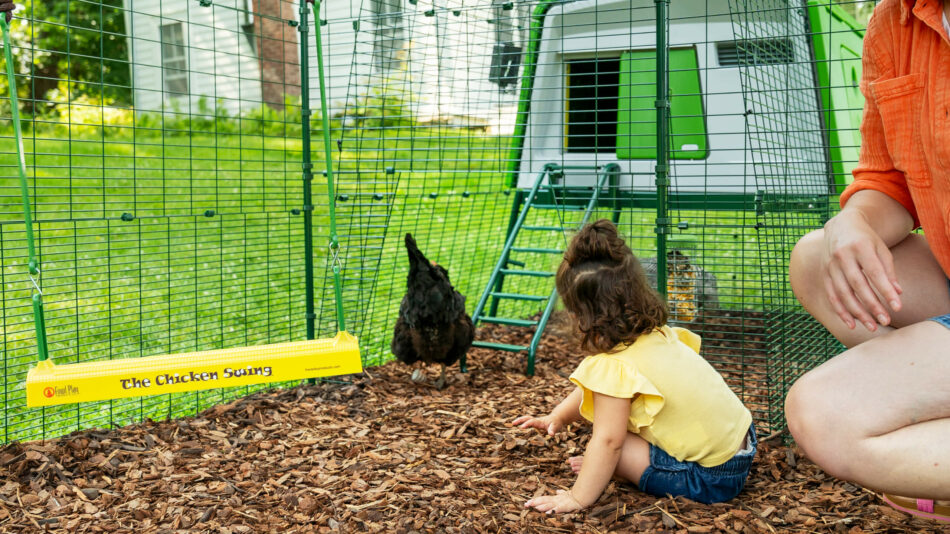
Common questions about keeping chickens
Questions are great when considering keeping a new pet. Doing your due diligence and researching how to best go about obtaining chickens, their housing, and their care is part of responsible pet ownership. Here are some of the most frequently asked chicken questions, and their answers.
Do you need to register your chickens?
Depending on where you live, you may need to register your chickens. There may also be chicken keeping laws that apply to your city or local homeowners association (HOA). Always check with your city office or HOA before making plans to keep chickens.
How many chickens make a perfect flock?
The most straightforward answer to this question is: it depends. Chickens are flock animals and have to be kept as a minimum of 2-3 at a time. Then your space, any laws or restrictions, and your egg consumption comes into play.
As a general rule, you will need to aim to provide at least 4sqft of space per chicken in their outdoor area. This can be done in a chicken run or with chicken fencing. The amount of space needed inside of their chicken coop varies depending on the size of your chickens, but an average amount of coop space is 2sqft per chicken.
A mature laying hen will produce an egg every day and a half, so a flock of 3-6 chickens will likely provide a steady supply of eggs for a small family. If your family consumes a lot of eggs, or if you plan to gift eggs to friends and family, you’ll want to expand your flock accordingly.
Do my chickens need to be vaccinated?
There are no required vaccinations for chickens in the US, and there are few approved vaccines for poultry. Some hatcheries vaccinate newly-hatched chicks with the following vaccinations:
- Marek’s Disease – affects the nervous system of chickens, and is usually fatal. Not all infected birds will show symptoms, but the virus that causes Marek’s can live in the ground for several years, making it very difficult to eradicate. The vaccine doesn’t prevent illness in chickens, but lessens the severity of symptoms. This disease is not contagious to humans.
- Coccidiosis – this common protozoa is a type of parasite that infects several different animals, but coccidia that infects chickens is specific to the avian species. Coccidiosis causes diarrhea and lethargy, and is fatal for most chicks. A vaccine shortly after hatching or feeding medicated chick feed until chicks are 16-20 weeks old will help prevent this illness.
Not all hatcheries vaccinate their chicks, and many do so per the buyer’s request. Always check with your veterinarian to see what vaccinations (if any) are recommended for your area.
Another chicken illness that has garnered a lot of attention lately is avian influenza. While this virus can infect backyard flocks, it’s rare outside of commercial poultry operations. There are no approved vaccines in the US for avian influenza in chickens, so monitoring your state and county news for updates on this disease is the best way to protect your flock. Use chicken run covers to prevent droppings from wild birds entering the run, and keep bird feeders put up or far away from your flock. Avian influenza typically follows a pattern of spiking before going dormant for several years.
Do chickens smell?
Chickens themselves are very clean animals, taking pride in preening their feathers and keeping their plumage healthy with regular dust baths. But their droppings do have an odor, so cleaning your chicken coop regularly is a necessity. Having an easy to clean chicken coop makes all the difference in turning this chicken-keeping chore into an anticipated activity. You can expect to clean your chicken coop once a week, with once a month deep-cleanings. Your flock’s run needs to be cleaned out seasonally, and spot cleaned throughout the week to remove droppings and old food. Keep your chickens’ run covered with a substrate like pea gravel, pine pellet bedding, sand, or hemp for quick cleaning and refreshing.
Omlet and your flock
See why countless families all over the world have decided to keep chickens – and why thousands of chicken keepers trust Omlet’s chicken coops, chicken runs, and chicken-keeping accessories to help their flocks stay healthy and happy. Starting your own flock is an exciting endeavor, resulting in priceless memories and many benefits. Take the poultry plunge with Omlet and discover chicken-keeping the way it was meant to be.


This entry was posted in Chickens
Bird flu, also known as avian influenza, is back in the headlines, and new restrictions have been imposed on chicken keepers. In these circumstances, it is natural to ask whether wild birds present a major risk.

Wild birds are not the main source of the spread of the disease, however, even though they can act as reservoirs for the virus. It is human commercial activities associated with poultry farming that are the major cause of the bird flu’s spread across the world. If you are keeping just a few chickens, most of the risks can be avoided by simple hygiene and protective housing measures.
Avian influenza (bird flu)
As its name suggest, the avian flu virus is a form of influenza (flu) biologically adapted to bird hosts. Avian influenza is not a virus specific to chickens and poultry, and in theory any bird, wild or domestic, can be infected.
Bird flu – good news and bad news
In theory, any species of wild bird can catch the flu. Waterfowl such as geese, swans and ducks are thought to be major carriers of the disease, sometimes displaying no symptoms themselves. Chickens that come into contact with avian influenza are likely to catch it.
But let’s look at the good news first. The risk to human health from wild bird diseases, including avian influenza, are extremely low. In 99.9% of cases, humans affected by the highly virulent H5N1 strain of the bird flu have caught it from intensively reared poultry. The disease is not easily transmitted from human to human.
Similarly, chickens that are kept in runs and subject to common sense precautions are unlikely to catch the disease. Unless you live in an area suffering a major avian influenza outbreak, the visitors to your bird table are unlikely to be carriers of the disease.

Now for the bad news… If only one wild bird in a thousand is a carrier of avian influenza, that’s still one too many. Like it or not, backyard chickens are at risk. This is why new rules and new housing measures were introduced in December 2020.
Avian flu in wild birds
The chances of a human catching avian influenza directly from birds that visit the garden are practically nil. This is no reason to avoid basic precautions, however, especially if you keep chickens. Keeping bird feeding stations clean is important, to avoid droppings and moulds accumulating. These can impact the health of wild birds and lower their immune systems. You should always wash your hands after restocking or cleaning a feeding station, or after any situation that brings you into contact with bird droppings (feeding the ducks in the local park, for example).
Sick or dead wild birds should not be touched. In general, you do not need to report the discovery of a dead bird. However, if dead ducks, geese, swans, gulls or birds of prey should be reported, as should the discovery of five or more dead birds of any species in one place.
How do I know if my chicken has bird flu?
Chickens with avian influenza will display various symptoms. They may be less active than usual, and will lose their appetite and show signs of nervousness. Their egg production will drop, and eventually their combs and wattles will look swollen, with a blue discoloration. Other avian influenza symptoms in poultry include coughs, sneezes and diarrhea. Unfortunately, many of these avian influenza symptoms are associated with other ailments, too, so a vet will need to make the diagnosis.
It can take 14 days for an avian influenza outbreak to spread throughout a flock. Some infected birds may exhibit no signs, even though they are still potential virus carriers. Others may sicken and die very quickly.
Guidelines from the CDC
If you are concerned your chickens may have been exposed to the the Avian Flu please follow these guidelines here to protect yourself at: https://www.cdc.gov/flu/avianflu/avian-in-humans.htm
CDC currently recommends a neuraminidase inhibitor for treatment of human infection with avian influenza A viruses. CDC has posted avian influenza guidance for health care professionals and laboratorians, including guidance on the use of antiviral medications for the treatment of human infections with novel influenza viruses associated with severe disease. Analyses of available avian influenza viruses circulating worldwide suggest that most viruses are susceptible to oseltamivir, peramivir, and zanamivir. However, some evidence of antiviral resistance has been reported in Asian H5N1 and Asian H7N9 viruses isolated from some human cases. Monitoring for antiviral resistance among avian influenza A viruses is crucial and ongoing.
Although avian influenza A viruses usually do not infect people, rare cases of human infection with these viruses have been reported. Infected birds shed avian influenza virus in their saliva, mucous and feces. Human infections with bird flu viruses can happen when enough virus gets into a person’s eyes, nose or mouth, or is inhaled. This can happen when virus is in the air (in droplets or possibly dust) and a person breathes it in, or when a person touches something that has virus on it then touches their mouth, eyes or nose
The main takeaway messages
- Feeding wild birds in the backyard is still safe
- Simple precautions and good cleaning habits minimize the dangers
This entry was posted in Chickens
Cockerels have three main purposes in a flock of chickens. They protect the hens by warning of any danger, they enable you to breed your own chicks, and they look fabulous. Sometimes, however, the cockerel’s protective instincts becomes a problem, and the bird becomes over-aggressive. This can be a particular issue in the spring, which is the breeding season.
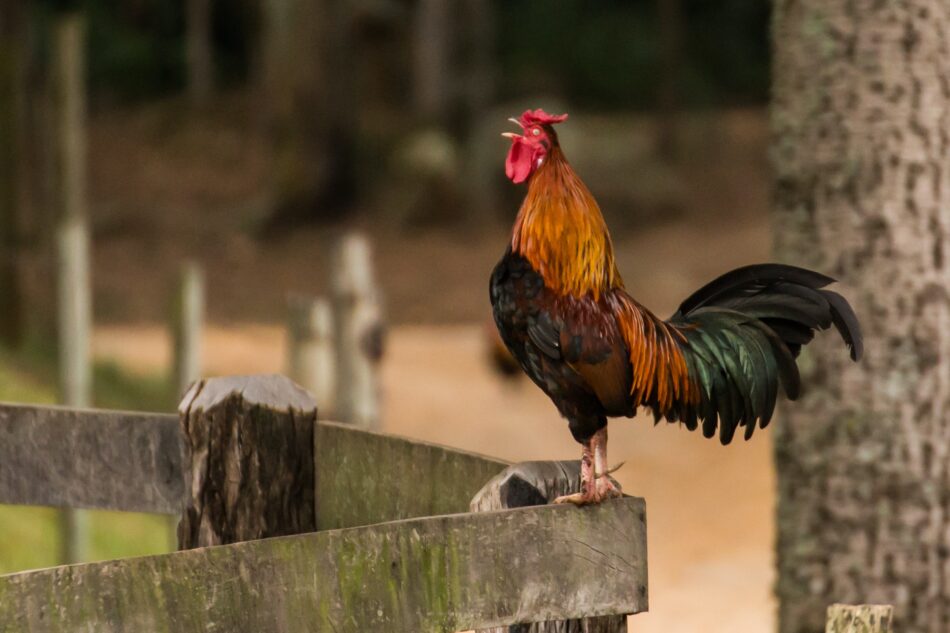
Cockerels are wired to protect their hens. If you watch the flock foraging in a garden, the loud clucking of a hen will bring the cockerel running to make sure everything’s okay. If a hen squawks when you pick her up, the cockerel will put on an aggressive display until you put her down again. As long as this doesn’t involve physical attacks, there’s no problem. Some cockerels will physically attack, though.
If these face-offs continue, the cockerel might decide that you – and all humans – represent danger and will try to fight you off at all times. Luckily, you can usually defuse the situation.
Cockerels give warning of their intention to attack. They lower their heads and perform a strutting dance while looking straight at you. Things get trickier if the cockerel decides to run up and attack your legs, like an angry farmyard goose. If you’re walking away, the cockerel may chase you from the yard, and that can cause nasty surprises too.
How Do You Stop a Rooster From Attacking You?
- Don’t walk straight towards the cockerel when you enter the place where the chickens are kept.
- Don’t stare at the cockerel unless he’s already behaving aggressively, as this is a sign of aggression as far as he’s concerned – you’re fixing your eyes on him and his flock just like a predator would.
- Don’t tiptoe around or run away if the cockerel looks at you, as these are signs that you’re afraid, and the cockerel might take this as a cue to rush in and finish the job!
- Don’t dash around the yard – the cockerel equates quick movements with predators. Go about your business in the chicken yard in a calm, slow but focused way.
- Make sure your hens are in a stress-free environment. If there are prowling dogs or unruly children running amongst the hens, their clucks and squawks will send the rooster into overdrive to protect his girls.
- If your cockerel brings you small ‘gifts’ such as stones or twigs, don’t be too flattered. He is treating you like a hen, and you will have to refuse the gifts and shoo him away, otherwise he will think he’s subdued you with his presents!
- Don’t crowd the cockerel. If he feels trapped in a corner, he is likely to fight his way out.
How to Handle an Aggressive Cockerel
Never respond to an angry cockerel with violence.
This will have no positive effect on the cockerel or flock’s behaviour afterwards, and it can result in serious injury to the bird. He may be aggressive, but a cockerel is still a bird, fragile bones and all.
A cockerel should be lifted with thick protective gloves to remove him to a safe place or away from the eye of the storm. Your arms and legs shouldn’t be bare when handling the rooster, and your footwear should be sturdy too. If the cockerel is only in the early stages of aggression, he can often be calmed down with a few treats. It is a good idea to carry treats with you whenever you’re in the same place as the cockerel. After you’ve fed him a few times, he will come to associate you with treats rather than danger. The treats should be hand-offered. If you throw them down and then run away, the rooster will recognise that you’re afraid, and the problems might continue.
A more hands-on – or feet-on – method is to gently roll the cockerel over with your safely booted foot when he approaches you looking for trouble. After a few of these gentle wrestling throws, the cockerel will realise that you’re the top bird in the run and give you no more trouble. In theory, at least!
How to Lift an Angry Cockerel
Alternatively, when the cockerel tries to peck you, scoop him up with your gloved hands and hold him like you would hold a hen, under your arm. The cockerel will flap and squawk angrily, but he will eventually calm down if you ignore these protestations. This may take 10 to 15 minutes, but it’s time well spent if it means that the cockerel will not attempt to attack you again.
If the cockerel has not yet attacked, you may be able to deter him by taking a large, deliberate step towards him, looking at him as you do so. If the rooster starts to fidget and looks at the ground or starts pecking it, you have won the battle, and you can back down without fear of attack.
The key to all these methods is to make the cockerel realize that you’re not a threat to his hens. Protecting the flock is all he wants to do. If that doesn’t work, and if the cockerel starts to stretch his wings and neck ready for attack, stretch out your arms. Carrying a stick can help here, as it makes your ‘wingspan’ look even greater in the rooster’s eyes.
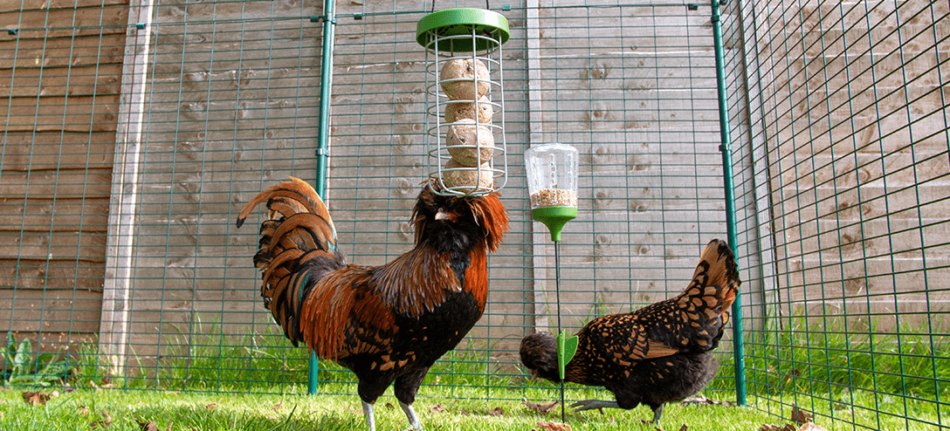
Treat holders and peck toys will keep your chickens entertained for hours!
What is the Most Aggressive Rooster?
Circumstantial evidence suggests that some cockerels are just born mean! In these cases, the cockerel’s instinct to protect a flock of hens is in constant overdrive. The aggression is occasionally seen when the birds are still chicks, although it is more usual for the aggression to kick in at 6 to 8 months old. Although the breed of the chicken makes a certain amount of difference, even supposedly gentle breeds can sometimes decide to take no prisoners in the chicken yard!
The most aggressive rooster breeds are said to be Aseel (allegedly the biggest bullies of all), Cornish, Leghorn, Malay, Old English Game and all other traditional ‘cockfighting’ or ‘game’ species.
What is the Least Aggressive Rooster?
The least aggressive roosters include the Australorp, Brahma, Polish, Silkie and Welsummer. Bantam breeds tend to be relatively calm, too. However, there are occasional ‘bad apples’ in all breeds, and some cockerels just seem to hit an aggressive streak and never entirely leave it behind.
Constantly aggressive roosters are a real problem, especially if you have children wandering in the garden or backyard. A cockerel readily backs up his anger with a physical attack, and he is armed with sharp spurs – the spikes on his legs – that can do real damage. If all attempts to calm the cockerel down fail, the tyrant rooster will have to be rehoused.
If you have chosen a non-aggressive breed of cockerel, and if your chickens have lots of space, you will seldom have major problems with rooster aggression. Let cockerels know whose boss as soon as they hit adulthood, never accept those tempting little gifts, and you should be recognized by all your chickens as being top of the pecking order.
This entry was posted in Chickens
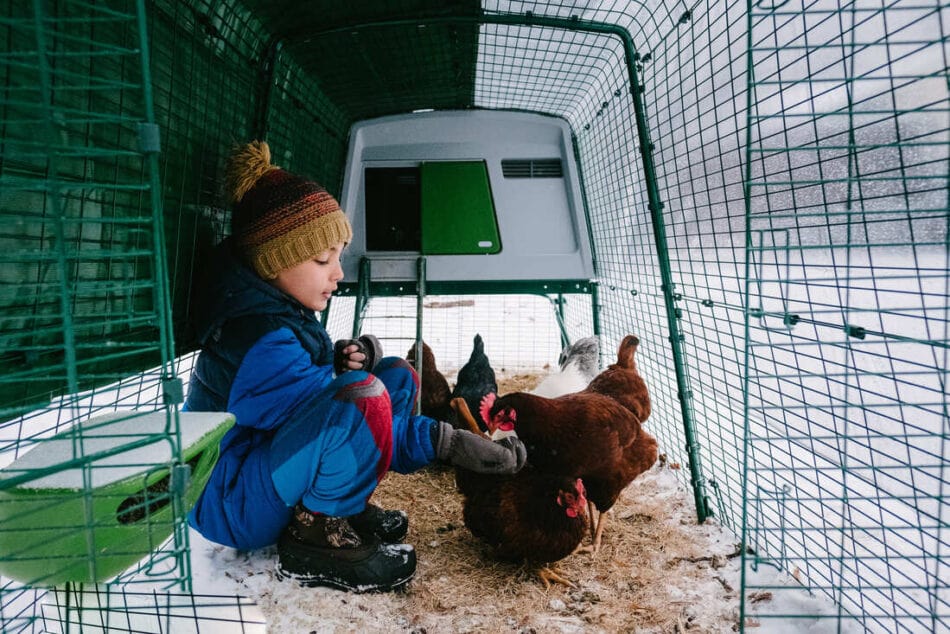
How cold is too cold for chickens? Chickens can tolerate cold weather, however, baby chicks are less likely to do so. The primary concern in cold temperatures is whether your chickens are becoming wet. If they are and cannot dry off, this can be cause for concern.
Our guide walks you through the optimum temperatures for chickens, how to care for your hens in winter, and which breeds are the most hardy.
How cold is too cold for chickens?
Chickens will regulate their temperature and behavior accordingly, so wherever humans can live, chickens can thrive too. Chickens can tolerate cold even under freezing temperatures. This makes caring for chickens in winter relatively simple, as only a few adjustments to your usual routine will need to be made. It is the combination of cold and wet that can prove fatal, so it’s vital to ensure your hens have a dry chicken coop. Any of your birds that become soaked should be toweled dry. Applying Vaseline to their combs will prevent frostbite and help them tolerate the cold.
Ideal temperatures for adult chickens
While chickens can tolerate the cold, their preferred weather is in the 70 degrees Fahrenheit range. You’ll find that your adult chickens can survive cold temperatures into the teens. However, we recommend keeping a thermometer in your coop to track its temperature. You should find that the insulation of your coop and the warmth created by the chickens themselves is enough to help them tolerate the cold.
Ideal temperatures for baby chicks
Baby chicks are far more sensitive to cold temperatures and are not able to tolerate them as well as full-grown hens. This is both due to their smaller size and the fact their feathers are not yet fully developed to keep them warm. When your chicks first hatch you should keep them at around 90-95 degrees Fahrenheit. After this you can reduce the temperature they’re kept at around 5 degrees a week until you get into the 70 – 75 Fahrenheit range.
Keep your chickens’ coop warm & cozy
The type of coop you have makes a big difference in how cold your chickens will tolerate. In really cold winters, a wooden coop with a drafty coop door can soon become damp and semi-frozen – not to mention very drafty. This dampness combined with the cold weather will make winter more difficult for be more tricky for your flock to tolerate.
On the other hand, a more robust state-of-the-art chicken coop such as the Eglu will keep out the cold and damp – enabling chickens to tolerate the cold weather after a busy day in their run. You’ll find that an Eglu will stay much warmer during the winter than a wooden coop. The temperature in the Eglu will remain moderate when all the hens are tucked in at night. Our Eglus are insulated by design, but if the winter becomes colder than usual you can easily add extreme weather protection to further insulate your coop.
You can help your backyard chickens keep warm in the frost and help them weather the cold by making sure the coop is clean and dry. Clear out any snow dragged in on the hens’ feet and keep an insulating layer of straw on the floor. Doing this will help your chickens to tolerate the colder weather. If you also insulate your chicken runs, there should still be some ventilation, to allow the gasses released from the birds’ droppings to escape.
An automatic door will help keep the living quarters cozy, too. It’s not advised to install a coop heater – even those rated for hen houses. Hens may get used to being overly warm all the time, which could be disastrous if the heater fails. Heat-pampered poultry can die of shock when introduced to lower temperatures, as they will not have become acclimated to tolerating the cold.
4 signs your chicken is too cold
When ensuring your chickens will tolerate the cold, it’s important to know the signs for when the weather may have made them uncomfortable. Here’s what to look out for:
- Ruffled feathers
- Perched off the ground
- One leg tucked up
- Wattles and combs are paler than usual
These are not signs of distress, and as long as the chicken is only having a brief rest, rather than staying hunkered up for the whole day, you don’t have to worry. If hens go off their feed, appear to be in shock, or have discolored (blue or black) combs, wattles or feet, it’s time to bring them inside to warm up slowly.
Keeping chickens dry in cold temperatures
While chickens can tolerate the cold, they should not be allowed to remain soaking wet. This is more dangerous than the outdoor temperature or the falling snow – and in extreme cases will result in hypothermia. Any affected hens will be stiff and cold to the touch, with their eyes wide and unblinking, or closed. If you find one of your chickens in this state, take them indoors and wrap them in a warm towel. When they recover, put them in a bedding-lined box in a warm spot for a few hours.
What happens if a chick gets too cold?
Chicks are less tolerant of the cold and are more susceptible to lower temperatures than adult chickens. If a young chicken has its full coat of feathers, it will be as tolerant of the cold as the older birds. Chicks, however, will need protection from the cold, and should be kept under an appropriate heat lamp. Any chick left to fend for itself in cold weather will die.
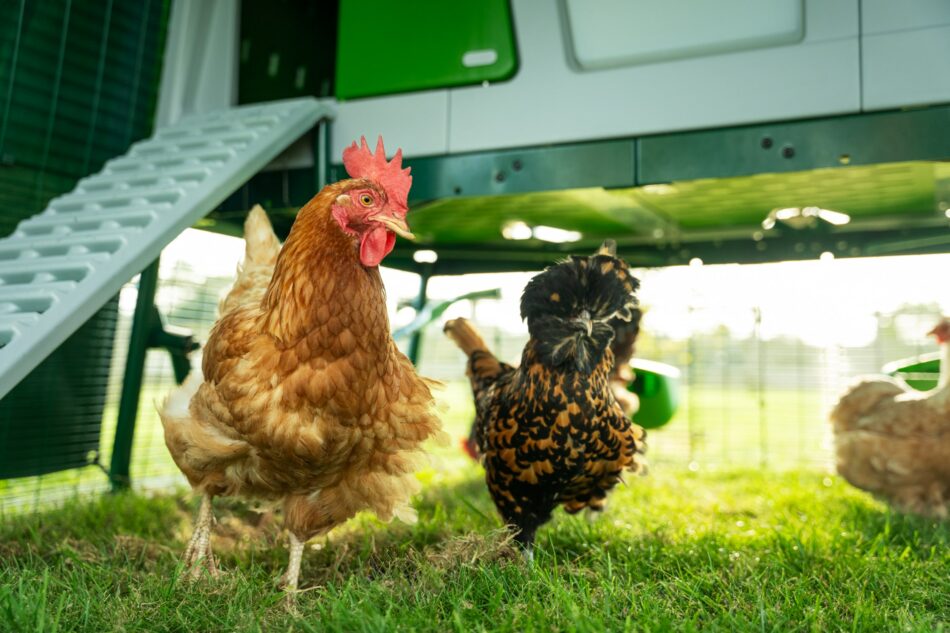
Tips for cold weather chicken care
Chickens can usually tolerate adapting to colder climates, but how can you tell when your flock needs a bit of help keeping warm? The following tips will help you keep happy, healthy chickens this winter:
- Prevent water from freezing – Check it at least twice a day to keep it clear of ice. If a freeze is forecast, bring the chicken waterers indoors at night. If possible, buy a water heater designed for the job of preventing freezing. Ping-pong balls in the water can also prevent freezing.
- Chickens usually return to the coop at dusk, but in the winter, you may find your birds trying to get more pecking time from the short days. If your hens tend to wander in the dark, a high visibility hen coat will help you locate them. The coats also keep the birds cozy, so it’s a double blessing in the Winter to help chickens tolerate the cold.
- Providing weather-proof shelter in the chicken run will give the hens some respite while tolerating the cold. You can use chicken run covers to do this.
- Some extra corn offered as a chicken treat before the hen’s bedtime will stoke their internal heater as the chickens digest it overnight. In general, hens will eat more food in the cold months to tolerate the cold, as more of their energy is spent keeping warm.
- Protect combs and wattles – from frostbite with petroleum jelly or Vaseline.
- Specially made coop heaters or brooder plates can be placed in enclosed spaces such as barns or garages for hens that are struggling in the cold, but should be used sparingly. And, these should only be used for a short amount of time, and only if someone will be home to avoid a potential fire-hazard.
- If you do not have a cozy Eglu, a wooden coop can be insulated with bubble-wrap, cardboard or old carpets or blankets.
- Extra bedding on the floor of the coop will help the chickens tolerate the cold, too.
- Some owners like to supplement their chickens’ diets with extra protein or a little suet, to increase their fat levels for the Winter. Fat retains heat, and the whole bird benefits from the added nutrition.
How do chickens naturally keep warm in the winter?
The chicken’s secret to tolerating the cold is natural insulation. Their feathers help them retain body heat and warm the air trapped beneath their downy base feathers. When they’re at rest, a hen’s body temperature is 104–107F, with their heart rate of around 400 beats per minute – evidence of a high metabolism that sets up the birds very well for winter weather.
Watching hens scratch at the frozen ground or strut through the snow, you might wonder how chickens manage to keep their feet and legs warm. After all, this is one part of their body with no feathers to keep it cozy (unless you happen to have a feathery-legged breed such as the Cochin, Brahma or Silkie). The answer lies in the chicken’s leg scales, which retain heat to a certain extent. The average chicken will always be on the move, not keeping all its toes on the ground for too long.
Does perching help chickens tolerate the cold?
Like many other birds, chickens often adopt the ‘one leg’ pose in the winter, tucking one of their limbs up into the warmth of their bellies. This reduces overall heat loss and stops feet and toes from freezing on the icy ground. Like all birds, chickens are warm-blooded, and their own body heat soon works its magic to help them tolerate the cold.
Perching is the most effective way for a chicken to retain body heat and tolerate the cold. Hens hunker down when roosting, with their feathers fluffed up and their legs tucked into her warm body. If space allows, install a flat perch in your coop or run. This will enable the hens to roost without having to curl their toes around the roosting bar, which will prevent their toes from freezing in very cold weather. An upturned pot, a log, pallet or other slightly elevated space will give the birds a flat surface to perch on, to escape the ice and snow.
Can chickens freeze to death?
Chickens can usually tolerate cold conditions and will not die, as long as they have a warm coop to retreat into when the weather becomes extreme. Cold hens may be more susceptible than usual to illness and parasites, though, and their egg production will fall. But, most chickens will simply hunker down on chicken perches and in nesting boxes, with their feathers fluffed out to weather the winter.
The best chicken breeds for cold weather
While most chickens can tolerate the cold, there are some chicken breeds that are more suited to cold climates than others. Here are the top 5 for cold temperatures:
Introducing Omlet pet care
Omlet can help you care for your chickens and ensure they’re enjoying each season to the fullest. From chicken pens to run around in, to toys such as chicken swings to keep them entertained, you’re sure to find everything you need to keep your flock healthy and happy all year round!
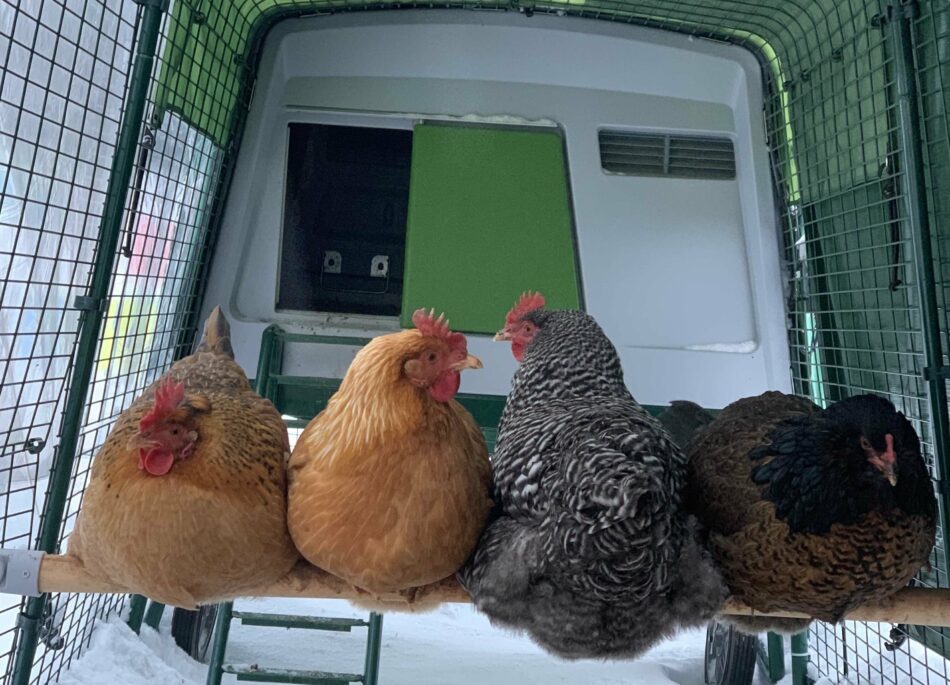
This entry was posted in Chickens
It’s nice to have chickens in your backyard but they need to stay there! Seeing them fly away and attempting to catch them again is not necessarily the easiest of tasks. It’s stressful for everyone and sometimes even dangerous for your chickens! So, what is the solution? Cut off their wings? Obviously not, but here are a number of flap busting techniques that may help to keep your feathery friends on the ground.
Why does my chicken want to fly away?
If you are dealing with a runaway chicken, it could be for several reasons. Each chicken’s character is different from one bird to another. While some like to lounge under a tree or in their chicken run, others prefer to frolic in search of freedom. This traveling and sometimes adventurous spirit can be associated with certain breeds of chickens. So, it’s not uncommon to find breeds such as the Leghorn or the Gauloise, for example, perched on a branch to rest. This is mainly due to their lighter weight in comparison to other breeds. Evolved with a fairly developed herd instinct, it only takes one chicken to take flight for the rest to follow suit.
However, sometimes your chickens may fly away, or even jump, not to rest but to escape a situation. A sudden or unusual situation can induce panic. A visit from a dog, the presence of a wild predator such as a fox, or the triggering of an unexpected high-pitched noise can stress your hens and cause them to flee. They then have two options: run or try to fly. Under stress, fear and panic they can easily surprise you and fly higher than you think. They may even injure themselves in a panic to get away. So how do you avoid this kind of situation?
How can I prevent my chicken from flying away?
There are three main precautions that can be taken when you have a flight-happy chicken:
Choose a quiet but well-placed area in your backyard to set up your chicken coop. If you have space, keep the chicken coop away from potential dangers: roads, parking areas, children’s toys. Here, your chickens should feel safe. Their chicken coop is their home, they need to be able to eat, peck and sleep in peace.
Invest in a fairly large enclosure. Having a high enough fence can deter them from trying to fly and protect them from potential animal attacks and external dangers.
An enclosed space, like the Walk in Chicken Run, is ideal for giving chickens a safe area to exercise and stretch their wings, without escape.
The third precaution is often known to chicken owners, but it is not often applied. However, this is an elementary precaution when bringing a bird into a chicken coop. It regards cutting the feathers of a single wing in order to unbalance your chicken and stop them from being able to take flight
. But how to do it? Take a pair of clippers and cut the flight feathers, that is, the larger feathers. You can also cut the primary and secondary flight feathers. The feathers must be cut halfway for it to be effective. Rest assured, we only cut Keratin (what our hair and nails are made of). It’s like going to the hairdressers!
Find the tutorial video “How to Clip your Chickens Wings (Safe and painless) (Easy to do)” by here.
Providing a comfortable living space, and large, safe enclosure will keep your hens happy and healthy in their home. And if necessary, wing clipping can be an effective solution for particularly determined escapees.
This entry was posted in Chickens
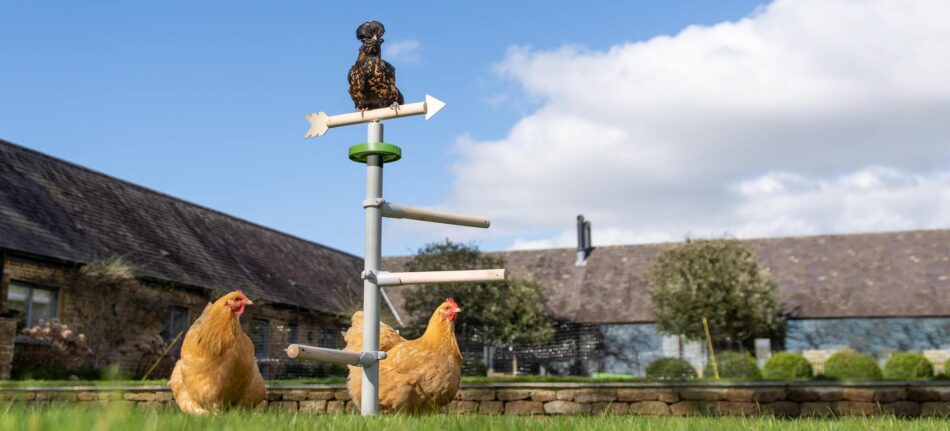
Most chicken keepers will fall into the eventually of “chicken math”. First, it was three, then four and now you’re thinking an eighth hen wouldn’t hurt…right? The idea of having flockmate best friends sounds great, but being the same species isn’t always enough for chickens to live in harmony. Certain chickens get along better than others, but which breeds make for besties?
Normal chicken behavior
All different breeds of chicken have been developed from the same ancestor, the Asian Jungle Fowl, and so fortunately, most chickens get along, regardless of the variety. However, there are some exceptions to this general rule.
Any new hen introduced to a flock will need to be separated from the other birds, but still be able to see them through a fence, for a week or so until all the birds get used to each other. Once introduced, they will find their natural place in the chicken pecking order, and that may involve a little bullying and squabbling in the early days. This is all very natural and has nothing to do with feuds between specific breeds.
Occasionally, one hen will fall out with another for no obvious reason, and the weaker chicken will sometimes be pecked and harassed by the more aggressive bird. If this situation continues for more than three days after introducing the new chicken, the two combatants may need to be separated.
What breeds of chickens are aggressive?
Some chicken varieties are more confident and assertive than others, but this does not make them aggressive. Aggression is usually the result of environment – poor living conditions – or visual stimulus. The chicken bullying only usually persists beyond the first few days if the new hen has unusual plumage on its head. The fancy crown of feathers on the Araucana, Houdan, Poland, Silkie and Sultan breeds, for example, is like a red rag to a bull for some hens.
The reasons for this aggression are purely instinctive. Chickens respond to the size of their fellow birds’ combs, and there is evidence that larger-combed chickens tend to dominate the pecking order and will challenge any large-combed newcomer to assert and retain her dominance. No one is entirely sure how the visual stimulus works with feather-crowned breeds. A chicken with feathers on its head is judged by the other hens to be one of two things – either a bird with a very large comb, and therefore a threat, or one with no comb at all, which makes it fair game for some bullying. Whichever way a hen looks at it, the feather-headed newcomer is a direct challenge to the dominant birds.
Birds with fancy head feathers are additionally vulnerable because the plumage flops in front of their eyes, impairing their vision, and so they may not spot an oncoming attack. This can result in pecks and injuries.
Other causes of chicken bullying
Other unusual feathering will occasionally inspire bullying amongst chickens, such as the feathered ‘trousers’ of the Faverolles. This is not generally a problem, though, and this breed should get along well with your other hens.
Sometimes, new chickens with no unusual feathers or peculiar combs may be picked on if they are a different breed from all the other hens in the flock. The bullying appears to take place simply because the new chicken looks different to the others. This is an unusual issue, though, and clearly, the problem disappears if your existing hens are a mixed breed flock.
Do chickens bond with each other?
In general, mixing breeds actually assists with the pecking order and the general bonding, as different varieties have different temperaments. There is more likely to be squabbling in a run that has chickens of a single breed – they may all be assertive and dominant, or they may all be shrinking violets, depending on the breed, but they still need to establish a pecking order.
The body size of the hen does not affect how it is treated. A dainty bantam can rub along fine with a hulking Sussex, and a cockerel will be respectful of all his hens, regardless of their breed, and in the vast majority of cases the birds will all get on well together.
There are other practical considerations when keeping a mixed flock. Some chickens thrive in cold weather, while others are not as robust. Age may be an issue too, if you want to minimize the number of changes in your chicken flock. This isn’t to say chickens of different ages can’t get along but older chickens are more likely to bully other flock members. If possible, wait until your younger birds are close in size before moving them in.
What chicken breeds get along best?
Some breeds are naturally friendly, and these varieties are far less likely to start pecking and bullying each other. Super-chilled backyard chickens include Australorps, Cochins, Easter Eggers, Rhode Island Reds, Silkies, Sussex and Wyandottes.
Omlet and your flock
Whether you’ve got a flock of ten or two, Omlet has the products to support the needs of your chickens. Keep your hens mentally and physically stimulated to help them live in harmony with our range of chicken toys and accessories to add to your chicken coop and chicken run.
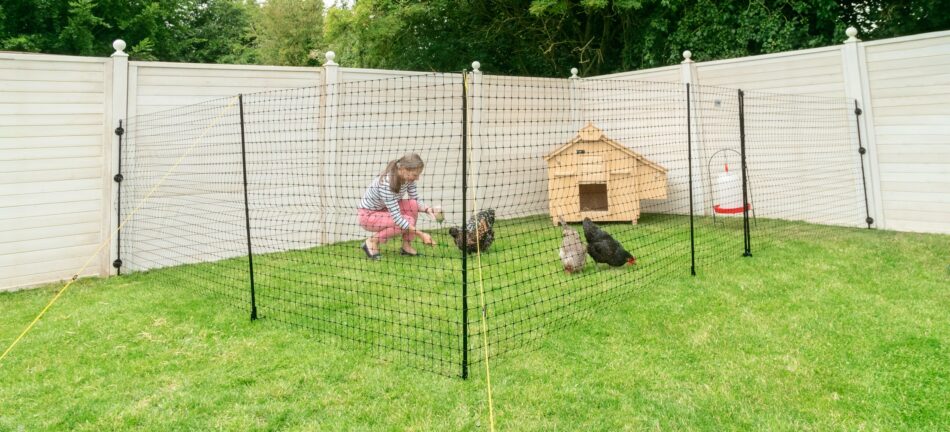

This entry was posted in Chickens

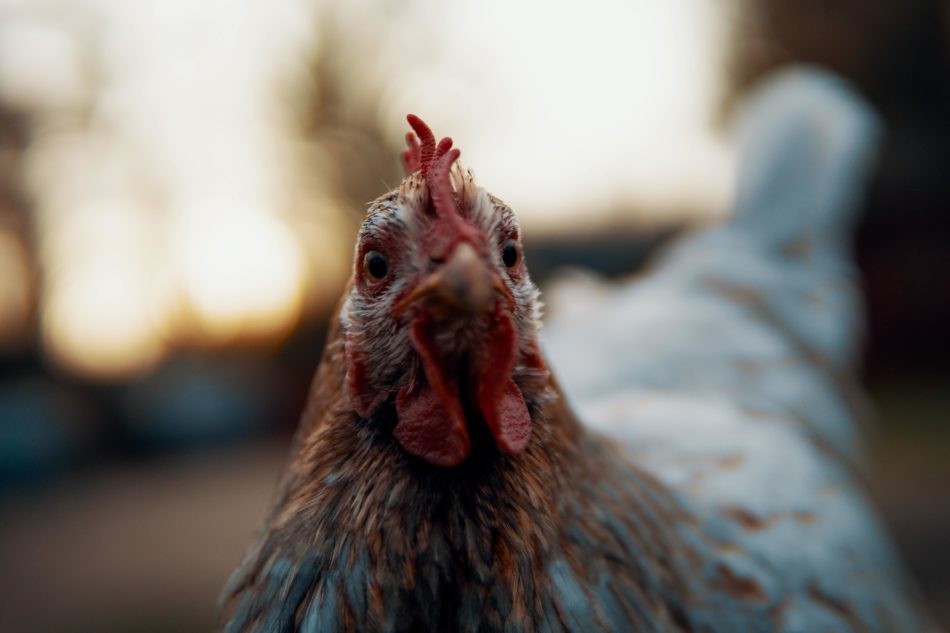
Only very tame pet hens enjoy being picked up. Most chickens find the whole procedure stressful, so you should only catch or handle them if you have to.
There are a few reasons why you might need to know how to catch a chicken. Your hens might be in danger, might require a clean-up after coming into contact with something oily or sticky, or you might need to carry out a chicken health check.
There are various ways to catch a chicken. If the hen is in danger as a result of escaping onto a road or into a backyard with a dog in it, you can usually manage things by ‘herding’ the chicken rather than trying to lift it. If a dog is the problem, controlling or confining the dog is the first thing to figure out. If the hen has escaped and you need to catch her, guiding her back to safety by standing with your arms stretched out to the sides and encouraging her to return to the chicken coop is the best option. In these situations, the chicken will desperately want to find her fellow hens, so ‘steer’ her towards the hole in the fence or the open gate, or whichever escape route she took.
If the hen has flapped over a wall, however, you may have to resort to old fashioned hunting techniques for catching chickens.
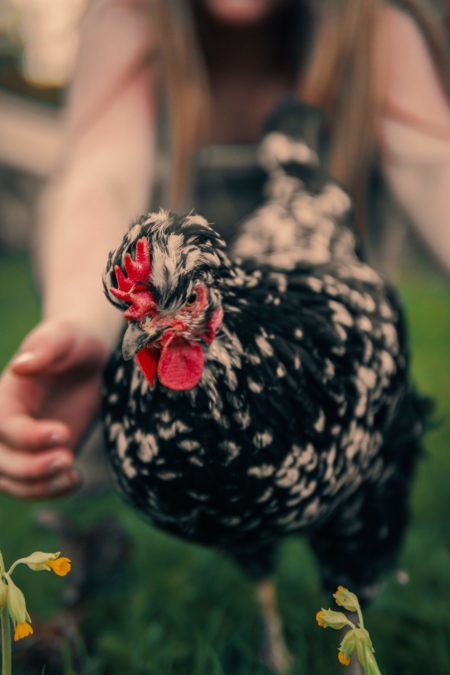 How Do You Catch a Stray Chicken?
How Do You Catch a Stray Chicken?
If your hens are very tame, you can simply offer some treats, bend down and pick them up. If only it were that easy with every chicken! Some are about as easy to catch as a fast-moving bar of wet soap – they can sprint at speeds of around 9 miles (14.5 km) per hour – and you will usually have to corner them first if you want to catch them.
If a hen has escaped or you spot her running away, or simply hidden somewhere in a large backyard or meadow where you can find to trace of her, the best approach is to be patient and rely on the chicken’s homing instinct. As dusk begins to fall, the hen will instinctively head back to the coop. This is one of the handy things about keeping poultry!
The Best Way to Catch a Chicken
Do chickens like being picked up? In general, the answer is no. But if you’re trying to catch a chicken for whatever reason there are various ways of doing so. Not all of them can be recommended for the non-expert chicken keeper.
- Using a pole with a hook or noose for catching a chicken. Let’s get the dangerous one out of the way first. A pole, hook or noose should only be used by experts when trying to catch a chicken. This is a dangerous tool, and in the wrong hands the poultry hook or noose can break a chicken’s leg or neck as you try to grab it, so our advice is to avoid it.
- Using a net to catch chickens. Nets can be dangerous tools, as a chicken’s claws can snag in the netting, causing injury. If you opt for this method, the chickens should be netted as quickly as possible to minimize stress – although forever afterwards the sight of that net will send the poor hen into a panic! You should always use as large a net as possible for catching your chickens. A blanket may offer a safer way to catch them.
- Using crate traps for catching chickens. Putting irresistible treats into a crate, and then slyly closing the door with a pole or long stick is an effective method. The main drawback is that all the other chickens will be tempted to take a look inside too!
- Boxes for catching chickens. A large box can be placed over a cornered bird in the coop or chicken run, and the flaps can be tucked in to secure the chicken. This technique can be useful if you need to capture chickens in daylight (although it works at night, too) and if they tend to be aggressive.
- Flashlights makes chickens easier to catch. This is the simplest and most effective method when you need to trap a roosting chicken. When chickens are with the rest of the flock in the coop or run on their roosting bars or perches or in their nesting boxes at night, they instinctively stay put. If you open the top of the coop and shine a flashlight (head-mounted ones are perfect), you’ll be able to pinpoint the hen you need to examine, and grab her up with minimal fuss.
Picking Up the Chicken
When picking up the hen, try to be firm but not rough. Getting a good grip and preventing the wings from flapping is the key. The correct method is to hold the chicken by placing your hand over its back, confining the wings, and then bring it close to your body. If the bird is very nervous, you may have to cover her with a towel to calm her down.
A tame hen is the easiest type of chicken to capture. Simply lure the hen in with a few treats, and grab her, stroking her back to reassure her. Once the cleaning or the examination is over, put the chicken on the ground and step back. She will do the rest, scuttling back to the safety of the flock.
So, there are several ways to catch a chicken, but you should only put them into practice when you definitely need to catch one. Try to avoid the poultry hook or net if you can, and use the method that suits both the chicken and the circumstances.
This entry was posted in Chickens
 Moving house is stressful for everyone involved – and that includes pets and chickens. As far as your hens are concerned, the secret to a successful relocation is to have everything ready at the other end. In the same way as you might unpack a kettle and two mugs before opening any of the big boxes, the chicken shed and run should be ready in the backyard before the first kettle boils!
Moving house is stressful for everyone involved – and that includes pets and chickens. As far as your hens are concerned, the secret to a successful relocation is to have everything ready at the other end. In the same way as you might unpack a kettle and two mugs before opening any of the big boxes, the chicken shed and run should be ready in the backyard before the first kettle boils!
Hens are prone to stress, and at the very least you can expect the egg count to plummet for a few days following a move. Weak or very nervous chickens are in particular danger, as panic can make them flap blindly and break legs, or even kill themselves. Minimizing stress is therefore the key to a successful move.
The most stress-free way to get your hens ready for the move is to collect and crate/box them from the coop, rather than later in the day when they are out and about and need chasing and cornering. That is not a good way to minimize stress!
 Transporting Chickens
Transporting Chickens
Your hen-carriers need to be covered, well-ventilated boxes or pet crates. They should have enough space for the birds to turn around in (to prevent them from panicking at the confined space), while being dark enough to make their instincts kick in and help them snuggle down for the duration of the trip. On longer journeys, however, you will need to have enough light in the boxes to enable the hens to feed, and pet crates will make this easier.
You’ll need one box per chicken, generally, so make sure you have enough boxes for the big day. Hens with similar, placid temperaments can be transported in a single box. Each box or crate should be lined with straw to soak up the droppings, and the boxes should be stacked securely, not more than three boxes high.
It is important that the birds do not get too hot on the journey, so ventilation is an issue. If you only have two or three hens, they could travel on the back seat of a well-ventilated car, secured with quilts or blankets – or even seat belts – to prevent the boxes from sliding around.
The journey itself should be taken using as many straight, non-bumpy roads as possible, combined with the need to make the trip as brief as you can. If your new home is a short stretch of highway and a couple of roads away, that’s all very straightforward. Rural locations with lots of windy-road options will need more planning. If all the roads are roads with lots of bends, the quickest route is the best option.
In the two weeks before the move, make sure your hens’ diet is rich in all the required vitamins and minerals. Some owners recommend adding probiotics or extra vitamins to the feed, and this is something you should discuss with your vet.
For short journeys, you will not have to worry about chicken feed. On longer trips, though, food will need to be provided. Make sure you take a long break at least every three hours, to allow the confined birds to settle down and feed. If you are transporting the hens in crates, you can attach a water dispenser to the side.
A Portable Chicken Coop?
Old fashioned chicken coops can be tricky to transport, and many hen keepers prefer to erect a new run and chicken shed at their new property. This sometimes involves housing the birds in temporary accommodation while the new coop and run are being sorted out.
There are ways of avoiding the inconvenience, though. A portable coop and run can be packed away and then installed in the new backyard in a few minutes, and they have the advantage of familiarity. Hens introduced into a coop that they already know inside out will reduce the stress of the move enormously.
Coops and runs such as the Eglu are ideal in this respect. Placing the coop in your new backyard as soon as you arrive will enable the chickens to feel at home before you’ve even managed to open any of your boxes. Humans will inevitably feel the stress of the moving-in process, but the hens don’t have to!
The process isn’t quite over when your hens are safely cooped up in the new backyard. Stress can cause any underlying diseases to bloom, so you need to carry out daily health checks on your birds as the flock settles down in its new surroundings. This is yet another reason to consider a pack-and-go portable coop and run.
This entry was posted in Chickens
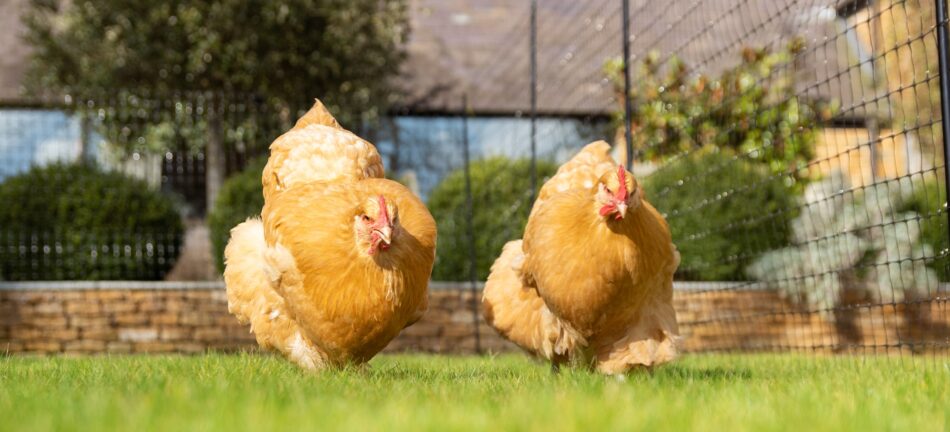
As with all pets, chickens rely on their owners for their safety and wellbeing. But as humans, vacations, spontaneous trips, and other time away from home are inevitable. So how will your chickens manage while you’re away?
Chickens are fairly self-sufficient, and do well when left alone. They don’t have separation anxiety from their owners like some pets experience, and can entertain themselves as long as they have their flock for company. Chickens will also regulate their feed intake and not overeat if free-choice food is left out for them. Still, they are prey animals, and certain considerations need to be taken into account before you take an extended leave of absence – particularly if no one will be staying with them while you’re away.
How long can I leave my chickens alone for?
Every chicken keeper does things a little differently from another, so the amount of time you can spend away from your flock is largely dependent on how you have them setup. Do they free-range, or are they always in a coop and run? Do you have an automatic door to tuck them in at night? Do you leave feed out, or feed them a portion daily?
When you prepare your chickens for your absence, you’ll need to make sure they have access to plenty of food and water. You’ll also need to make sure that they stick to their regular schedule as closely as possible. If they’re accustomed to free-ranging during the day and being closed in at night, you’ll need to have a safe, contained space large enough to simulate free-ranging.
An Eglu Cube chicken coop connected to a walk in chicken run is a great option for chickens that are accustomed to free-ranging, or for flocks that crave space during their time out of the coop. The run can be extended to however large you’d like to make it, so space is never an issue. And with the anti-dig skirting, predators will be deterred from coop-crashing while you’re away!
Give the setup and routine that you plan to have while you’re away a trial run before you leave to make sure everything goes smoothly. If any changes need to be made before you leave, you’ll want to give your flock ample time to adjust. Chickens will adapt quickly, so if your trial run was a success, your chickens should be just fine if you’re gone over the weekend.
Should I get a chicken sitter?
Leaving chickens alone for a day or two is commonplace for most flock-raisers, but if you are gone longer than that, it’s a good idea to have someone come and check on your chickens while you’re away. Depending on the time of the year, chickens can go through their feed and water quickly, and one misplaced step or a visit from some neighborly mice can empty a food or water container in a hurry!
Consider asking a neighbor or a family friend that enjoys chickens to stop by and check in with your hens. A quick glance is often all it takes to ensure your flock is thriving while you’re away. You can always offer for them to take whatever eggs your hens have laid while you’re away as repayment and token of your (and your hens’) thanks!
If you have an automatic chicken coop door, be sure to let your chicken sitter know what time it opens and closes, or ask if they have a preferred time to go and check on your flock. Make sure to reprogram your automatic chicken coop door (if open or close times need to be adjusted) well in advance to get your hens accustomed to a different bedtime if necessary!
What do my chickens need while I’m away?
Food and water
Make sure to fill all of your chickens’ feeders and waterers before you leave. If possible, anchor any free-standing feeders or waterers to the sides of the run or coop to prevent them from being knocked over. Keep waterers sheltered from blowing debris to prevent them from getting clogged.
Prep for different weather
Consider the time of year you are leaving and plan accordingly. Always prepare for precipitation – even if there isn’t any in the weather forecast! Make sure your chicken run cover is on to provide shade and protection from rain.
Entertainment
If your flock is used to daily visits and treats from you, they will likely miss it while you’re away! To head off any treat-pining or fear of missing out on playdates, offer some fun alternatives such as a Chicken Swing or a variety of chicken toys to keep them occupied. To really stay in their good graces, set out some treats in a chicken peck toy or Caddi Treat Holder. Your flock might not even notice you’re gone!
Good to go
With proper preparation and planning, traveling can still be part of your lifestyle when you have chickens. The easiest way to maintain a flexible schedule with chickens is to create a setup that allows for flexibility from the beginning.
It’s always easiest to start off with the ideal setup for your flock so that your future travel plans don’t interfere with their routine. Large chicken coops with walk in runs, automatic chicken coop doors, and weather protection are all components of raising happy and safe chickens – whether you’re home or not!
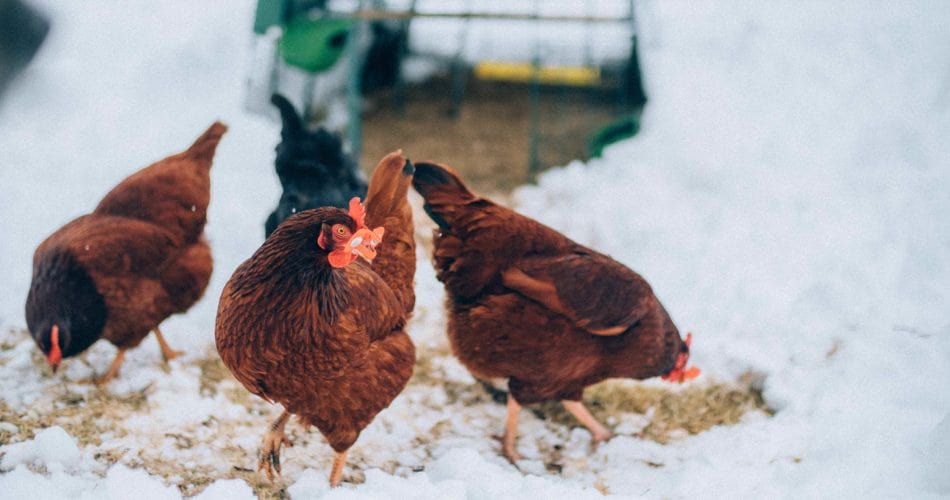
This entry was posted in Chickens

Introduction:
As November and December start to roll in, the cold weather will come with it. You may have already purchased the Omlet Eglu Cube or Go-UP to keep your chickens cozy during these cold nights. However, who said you do not want to spoil your chickens even more over the holiday season?! It is the season of giving after all! Below is some information on feeding your chickens in colder months and some “egg-cellent” treats that you can surprise your hens with on a cold, blustery day that they will absolutely love!
Blog Summary:
- How often should I feed my chickens during Winter?
- What is the most comforting treat?
- What are the easiest treats to prepare?
- What are the most nutritious treats for your flock?
- Conclusions
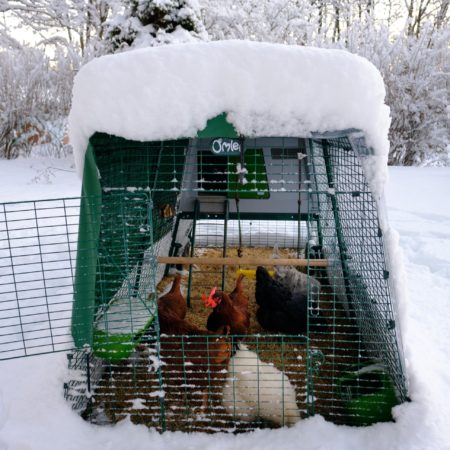
1. How often should I feed my chickens during Winter?
During the colder months it is normal that other animals hibernate and usually stock up on food for the Winter. With your chickens it may be helpful to feed them a little more than their usual ration, especially if you are planning to have your chickens continue to lay eggs throughout the colder season. A good rule of thumb is if you feed them 1 time a day, give them half of an extra ration in the Winter.
2. What is the Most Comforting Treat?
If you have already bought some pumpkins to paint or to decorate your doorstep with in the Fall Season and are wondering what to do with them here is a solution, Pumpkin Puree! This is a great treat for your hens that you can easily whip up in minutes.
All you have to do is scoop out the seeds and cut the pumpkin into small enough pieces that they can be put in a food processor or a blender. Then, just blend it up until it is a nice, smooth consistency for your chickens. After you have pureed the pumpkin, take it straight out to your chickens and add some chicken feed and they will go crazy!
Another option is also to warm up the Pumpkin Puree for a warm treat on a colder day! Make sure that the puree has cooled down to a comfortable temperature before you feed it to your hens.
3. What are the easiest treats to prepare?
Sometimes simpler is better and these treats will definitely keep your hens happy and maybe give you a little laugh in the process.
One easy treat to give your hens is leftover pasta! Who knew that chickens like to load up on carbs in the Winter as well! If you have some leftover spaghetti or penne toss it into the chicken pen and you will get a good laugh watching the chicken have noodles hanging from their beaks.
Another easy treat is warm oatmeal! Just add hot water and stir. You can also add some chicken feed or any nuts and seeds that your chickens prefer. You will be amused watching your chickens try to slurp up the warm oatmeal. Again, make sure the oatmeal is at a comfortable temperature to serve to your hens.
4. What Winter Foods Are Healthy for my Flock?
For those of you that like to keep your flock in tip top shape here are some ideas for healthy treats. One food that helps with egg production and is very nutritious is scrambled eggs! I know it sounds crazy, but it provides your chicken with needed protein and vitamins during the Winter months.
Also, egg shells believe it or not will provide your chickens with extra calcium and nutrients that they will need even more during the colder months. After you have used one of your chicken’s eggs just break up the shells into small pieces and feed it to them. They will love it!
5. Conclusions
All of these recipes can be found from this great website: https://morningchores.com/chicken-treats/. Go check out her page for more ideas on treats for your chickens and help your chickens stay warm and cozy this season!
Psssst… Read More About Fun Pet Tips and Tricks Here: https://blog.omlet.us/
This entry was posted in Chickens

Chickens are great foragers, and free-range birds will peck and scratch for all kinds of wild treats, from grass and weeds to worms and beetles. However, even a hen with all-day access to a backyard or meadow still needs to be fed with high-quality layers pellets. These contain the correct balance of protein, carbohydrate, vitamins and minerals (notably calcium for eggshells) that will keep them happy and healthy. Protein is particularly important for healthy egg production.
A general ballpark figure is very useful, to guarantee that the hens’ dietary requirements are being met. For medium-sized breeds such as the Rhode Island Red, Oxford Brown or Orpington, you need to feed between 115 and 120 grams (just over a quarter of a pound) of feed per chicken per day, which is 805 to 840 grams (one and a half pounds) of feed per chicken per week. A slightly larger Sussex will eat a bit more, and the smaller Leghorn will eat slightly less, while a small bantam breed will only eat between a half and three quarters of that amount.
Chicks, Pullets and Layers
Until it is five weeks old, a chick will need to have its diet supplemented with protein-rich ‘chick crumbs’. Between then and 18 weeks old, while they are ‘pullets’, the birds will need ‘growers’ pellets’ to put on weight. As soon as the hens begin laying, they only need the regular ‘layers pellets’. These, again, are rich in protein, calcium and all the other essential nutrients.
The hens will also need daily access to grit. Treats are fine, as long as they are not being offered so frequently that the hens fail to eat their share of pellets. Corn is a healthy treat, and birds that have free-range access to grass will be in chicken heaven.
How Can You Make Sure Each Hen is Getting Her Share of the Food?
Any flock of chickens develops a natural pecking order, and the dominant birds will tend to eat their fill before the others, if there is not enough space for all the hens to fill their crops at once (something they like doing shortly before retiring for the night). A solution here is to buy a wide-bottomed feeder that allows several birds to eat at once, or to use more than one feeder. This will ensure the timid hens get their fair share of food.
However, as long as you have provided enough for all your hens, there should always be food left in the feeder when the dominant birds have had their fill. You should still keep a close eye on the health of your flock, though. Issues such as soft shells or feather-plucking can be signs of dietary deficiencies, and the problem might lie in the quality rather than the quantity of the birds’ diet.

Do Hens Eat the Same Food All Year Round?
Chickens molt every year, and will usually eat more food during this process, to ensure their bodies have all the protein they need to grow a new set of feathers. Hens usually eat more during cold weather, too, in order to fuel their metabolisms and stay warm. Free-range hens also tend not to find as many treats in the backyard during the Winter, as the insect population is at low ebb and the grass is no longer growing.
You can add a little more food each day during these periods. You will soon know if you are giving them too much or too little, by noting the number of pellets left in the feeder each evening.
However, the hens produce fewer eggs in the Winter, so all in all the number of protein-rich pellets required does not differ significantly from season to season. Again, the key detail is to ensure a regular supply of food. In the Summer, if your hens appear to be eating very little, it may be because they are finding too many good things on their foraging trips in the backyard. This can be a problem if the wild food they are filling up on does not provide the right balance of nutrients. You might want to confine a hen to the coop if she does not seem to eat enough pellets. That way, she will be forced to eat the good stuff rather than the backyard treats.
Layers pellets should be available to the hens 24/7 – they will eat as much as they need, and will not behave like a dog, eating everything at once simply because it is there!
This entry was posted in Chickens
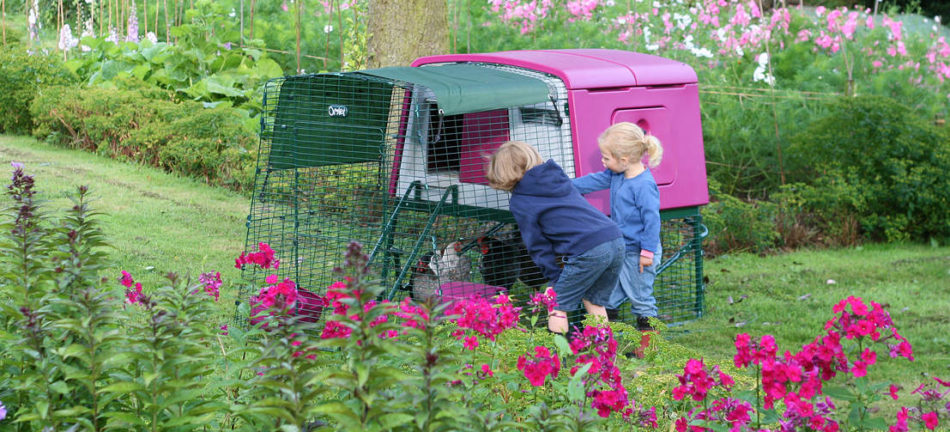
Chickens really are wonderful pets for the whole family. Aside from providing delicious daily eggs, they’re super fun to watch, hang out with, and can teach children valuable life lessons. Compared to other pets, chickens are also relatively low maintenance, and caring for them doesn’t really require much that children from primary school age won’t be able to at least take part in. Read on to find out more reasons why chickens are great pets for families with children.
Responsibility
Having chickens will help children of all ages learn about taking responsibility for another living being. Whilst they should never be given full responsibility for all the chook care duties, even allowing them to scatter some corn for their feathered friends or refilling the drinker can help children build a wondrous connection and gain a better understanding of what it means to take care of another.
Routines
Chickens are pets of routine and part of your daily regime as a keeper includes, but is not limited to, cleaning out the coop and run, filling their feed and waterers and collecting eggs. Having pets that need structure helps children to understand the importance of a routine, which, is something many kids can thrive with,
Food
Keeping chickens will teach your children that food does not magically appear on supermarket shelves. If they care for their own chickens, they’ll hopefully realize how important it is for animals to have enough space and adequate care, and they will not take animal products for granted.
Chickens and children: things to consider
Dream big, start small
Whilst you might be tempted to start off with more, begin with a smaller flock of no more than 5 chickens. That way, your children will easily be able to differentiate them and give them names based on their personalities. Too many at once makes the chickens seem like a flock rather than a group of individuals. And at a later date, there’s nothing stopping you from falling victim to the infamous “chicken math” when your children are older!
Happy hens
Stick to hens. It’s probably a good idea not to get a rooster to start with. Whilst some chicken keepers have their own personal reasons as to why they want to keep roosters, they’re not for everyone. For one, they’re much more confident and pushy than hens and can be a bit intimidating for younger children.
Easy peasy coop cleaning
Get a coop that makes chicken keeping easy, so that the kids can help. The Eglu Cube chicken coop is perfect for adults and children alike. With the innovative design, even younger members of the family can even help with the cleaning of the coop. Simply empty the dropping tray and wipe down the smooth surfaces of the house once a week, and your coop will look shiny and new every time.
It’s super easy to let the chickens out in the morning and close the coop at night too with the optional Autodoor. Plus, collecting fresh eggs is a breeze with the egg port found on the side of the coop.
Start them young
Even if you’re not incubating eggs and rearing chicks yourself, getting young chickens is a good idea if you want your children to be involved. Encourage regular interaction, and try to pick up the chickens regularly to get them used to being handled. This is sometimes made easier by having the chickens in a run that is easy to access, like the Walk In Run.
Which breed?
There are a number of chicken breeds to choose from, all of which with their own pros. When choosing chickens as family pets though, opt for a friendly and hardy breed that’s renowned for getting on well with kids. Silkies, for example, are famous for being loving and happy to be held, Orpingtons are calm and affectionate and Cochins easily adapt to any situation they are confronted with.
Omlet and your family pet
Whether you’re a first-time chicken keeper looking for a new family pet or expert, Omlet has everything you need to give your chooks the best lives possible. From our range of easy-to-clean chicken coops, to our Autodoor to take the guesswork out of bantam bedtime, chicken keeping has never been more simple or fun than with Omlet.
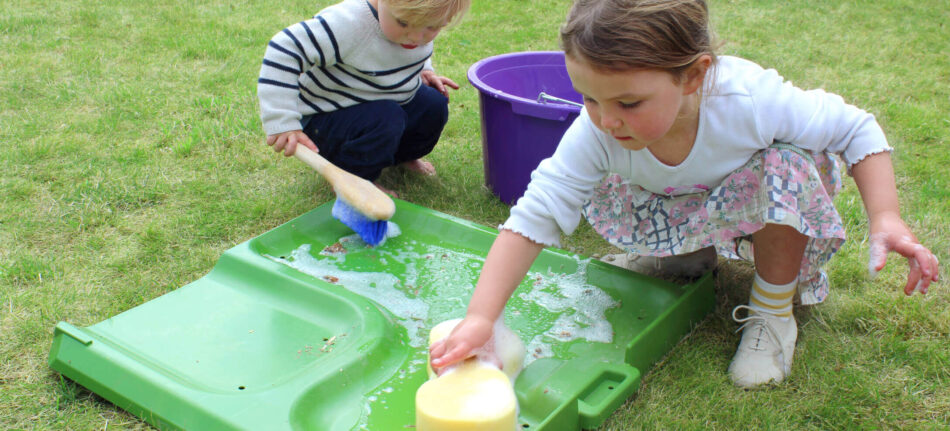
This entry was posted in Chickens










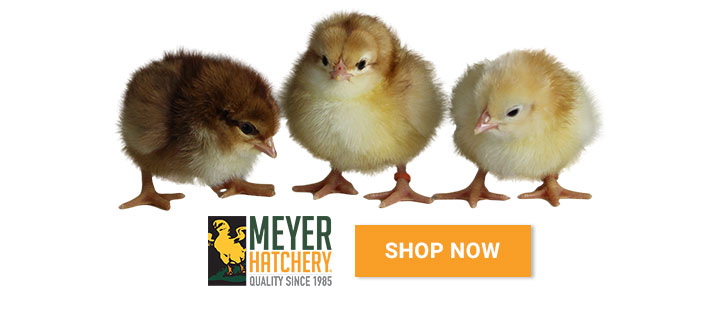


 Potatoes, tomatoes, and aubergines (eggplant) are in the Nightshade family, and they are toxic for chickens. That applies to all raw forms of these foods. The toxic ingredient, solanine, is broken down when the plants are cooked, and so cooked potatoes or tomatoes will not cause problems.
Potatoes, tomatoes, and aubergines (eggplant) are in the Nightshade family, and they are toxic for chickens. That applies to all raw forms of these foods. The toxic ingredient, solanine, is broken down when the plants are cooked, and so cooked potatoes or tomatoes will not cause problems. 














 Having some feathered friends in your backyard who regularly lay eggs for your enjoyment – that sounds good, doesn’t it? But there are a few things to consider before raising and keeping chickens in your backyard. Whether your garden is suitable for chicken keeping or the actual costs which are involved… In this respect, we’re going to be “egg-ucating” you today with some advice and guidance!
Having some feathered friends in your backyard who regularly lay eggs for your enjoyment – that sounds good, doesn’t it? But there are a few things to consider before raising and keeping chickens in your backyard. Whether your garden is suitable for chicken keeping or the actual costs which are involved… In this respect, we’re going to be “egg-ucating” you today with some advice and guidance! In addition, there are costs for the vet, which can hardly be calculated. The vaccination costs are still quite manageable, the vaccine itself is a maximum of $30
In addition, there are costs for the vet, which can hardly be calculated. The vaccination costs are still quite manageable, the vaccine itself is a maximum of $30  to keep your pullets safe. You can buy a pre-made coop or you can build your own.
to keep your pullets safe. You can buy a pre-made coop or you can build your own.  In order to keep healthy and happy chickens it is necessary to have a safe outdoor area with plenty of space, where they can exercise and enjoy the sunshine and fresh air. Your chicks should be able to go about their normal behaviors, such as scratching, foraging and dust bathing.
In order to keep healthy and happy chickens it is necessary to have a safe outdoor area with plenty of space, where they can exercise and enjoy the sunshine and fresh air. Your chicks should be able to go about their normal behaviors, such as scratching, foraging and dust bathing. 










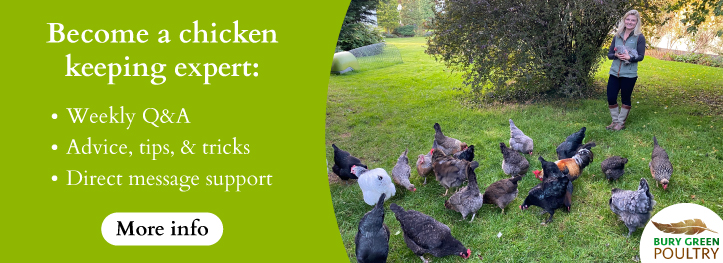









 How Do You Catch a Stray Chicken?
How Do You Catch a Stray Chicken? Moving house is stressful for everyone involved – and that includes pets and chickens. As far as your hens are concerned, the secret to a successful relocation is to have everything ready at the other end. In the same way as you might unpack a kettle and two mugs before opening any of the big boxes, the chicken shed and run should be ready in the backyard before the first kettle boils!
Moving house is stressful for everyone involved – and that includes pets and chickens. As far as your hens are concerned, the secret to a successful relocation is to have everything ready at the other end. In the same way as you might unpack a kettle and two mugs before opening any of the big boxes, the chicken shed and run should be ready in the backyard before the first kettle boils! Transporting Chickens
Transporting Chickens






